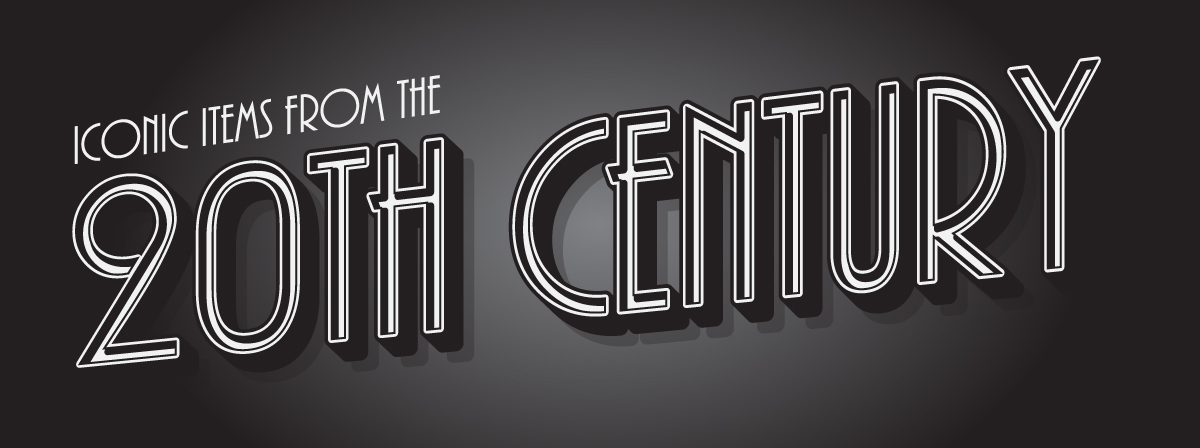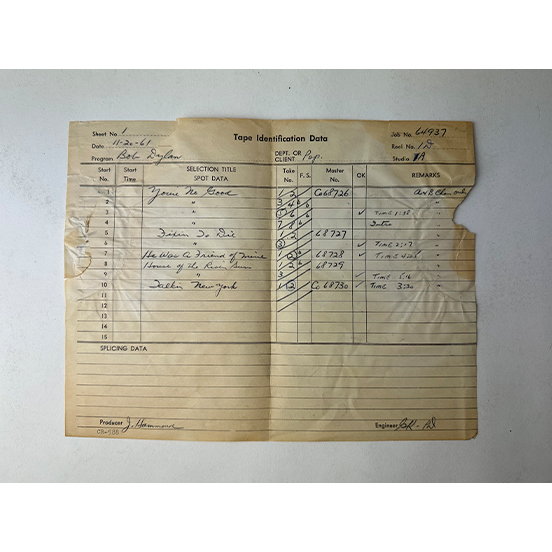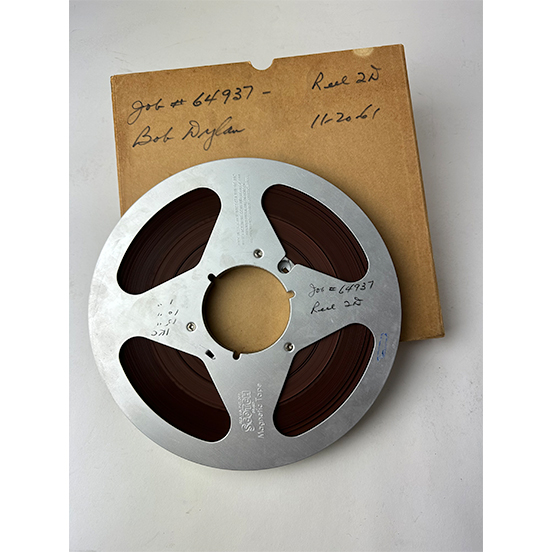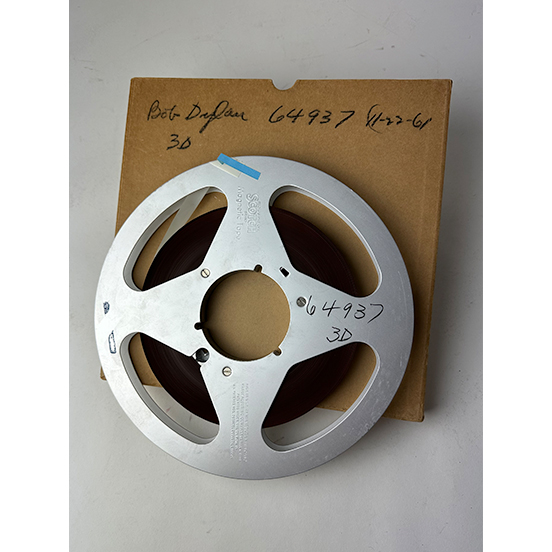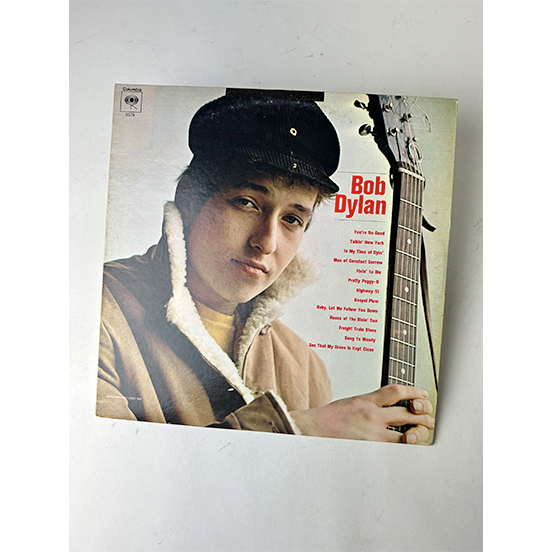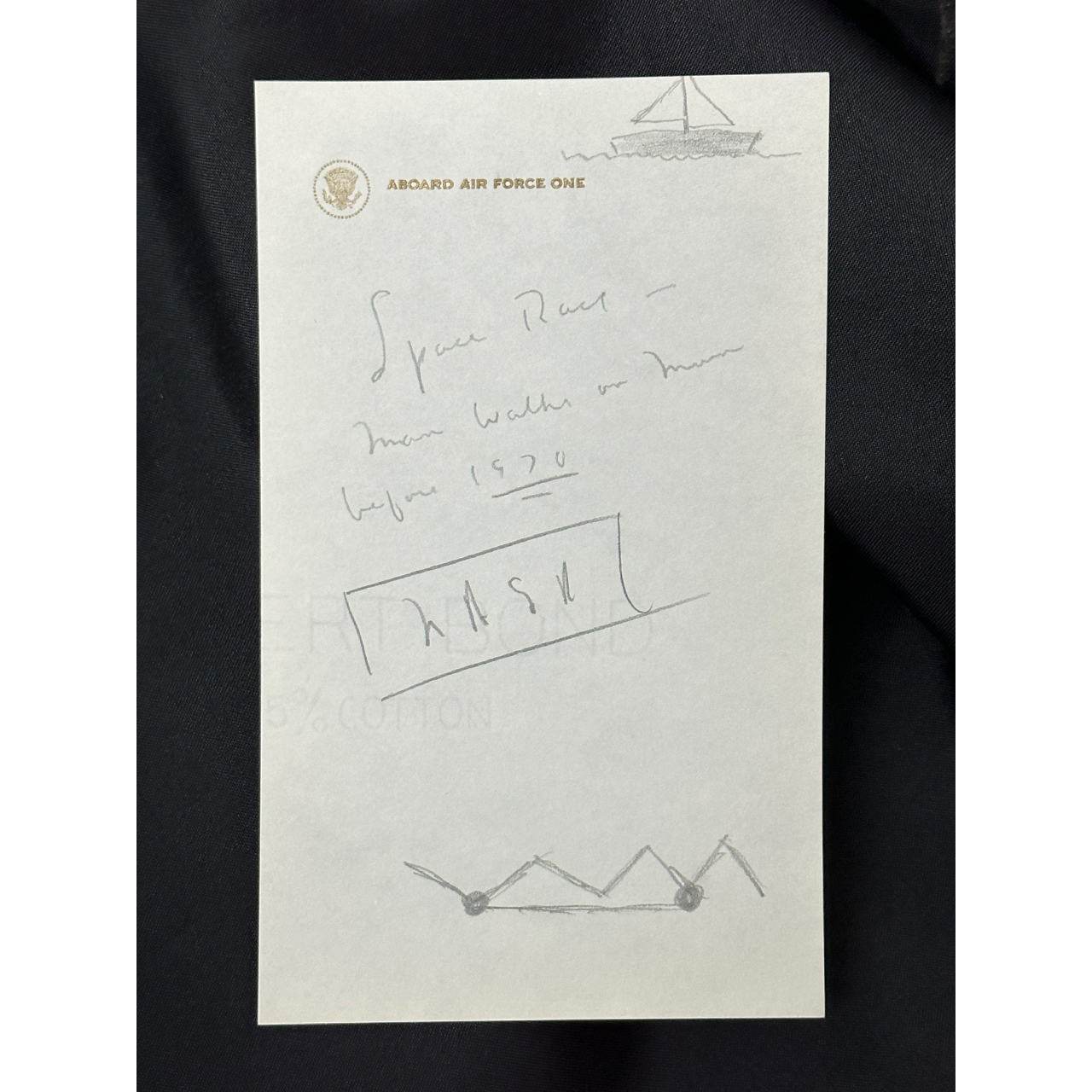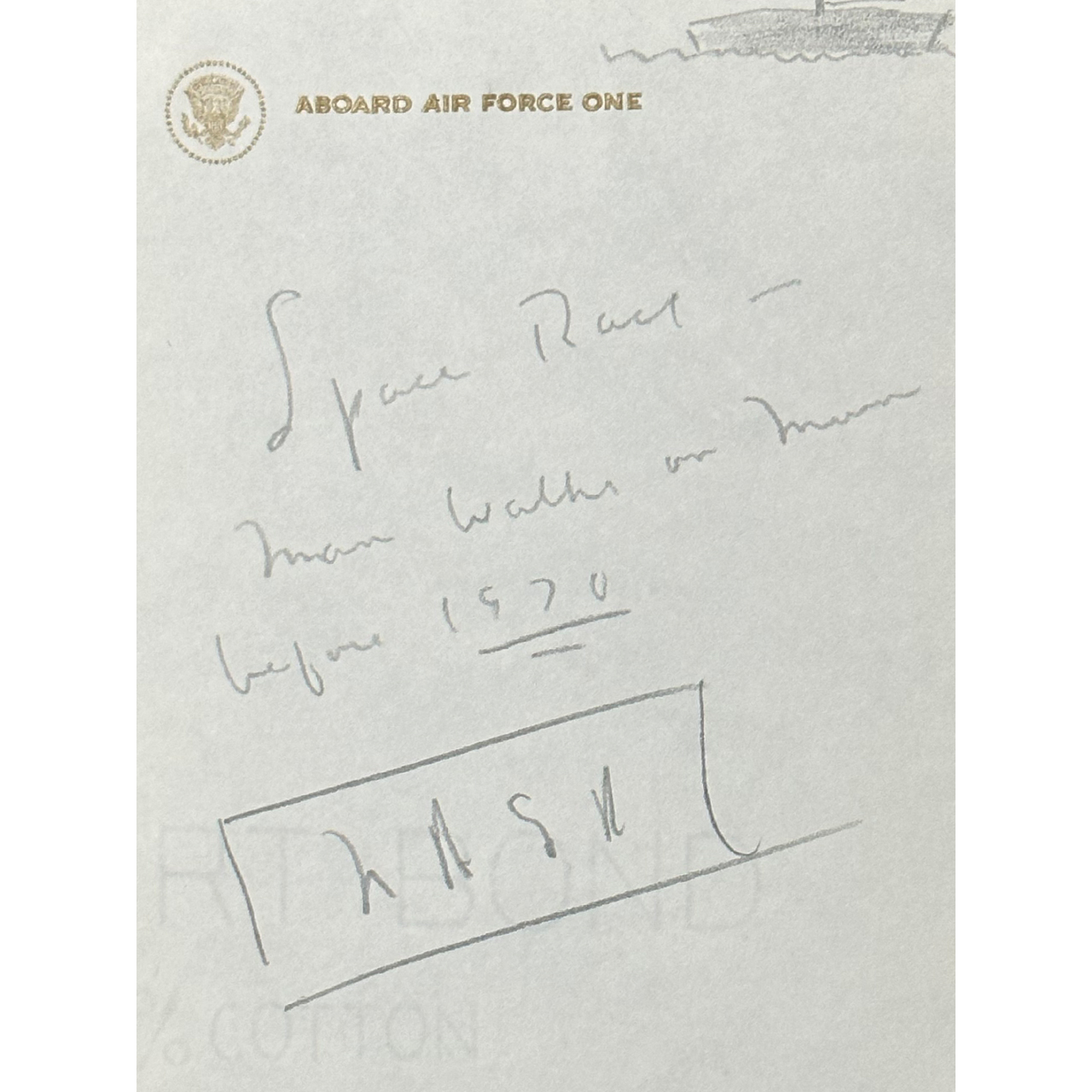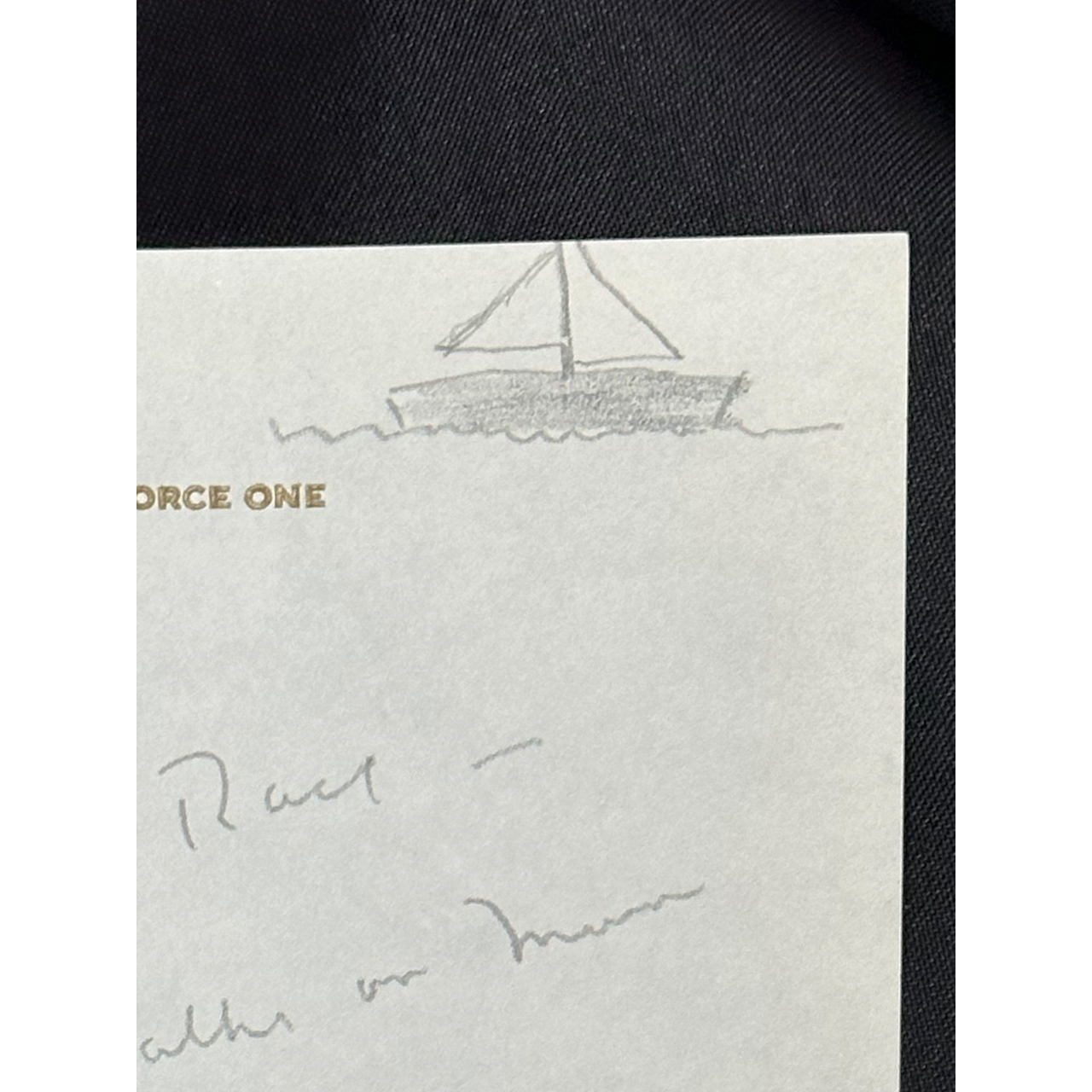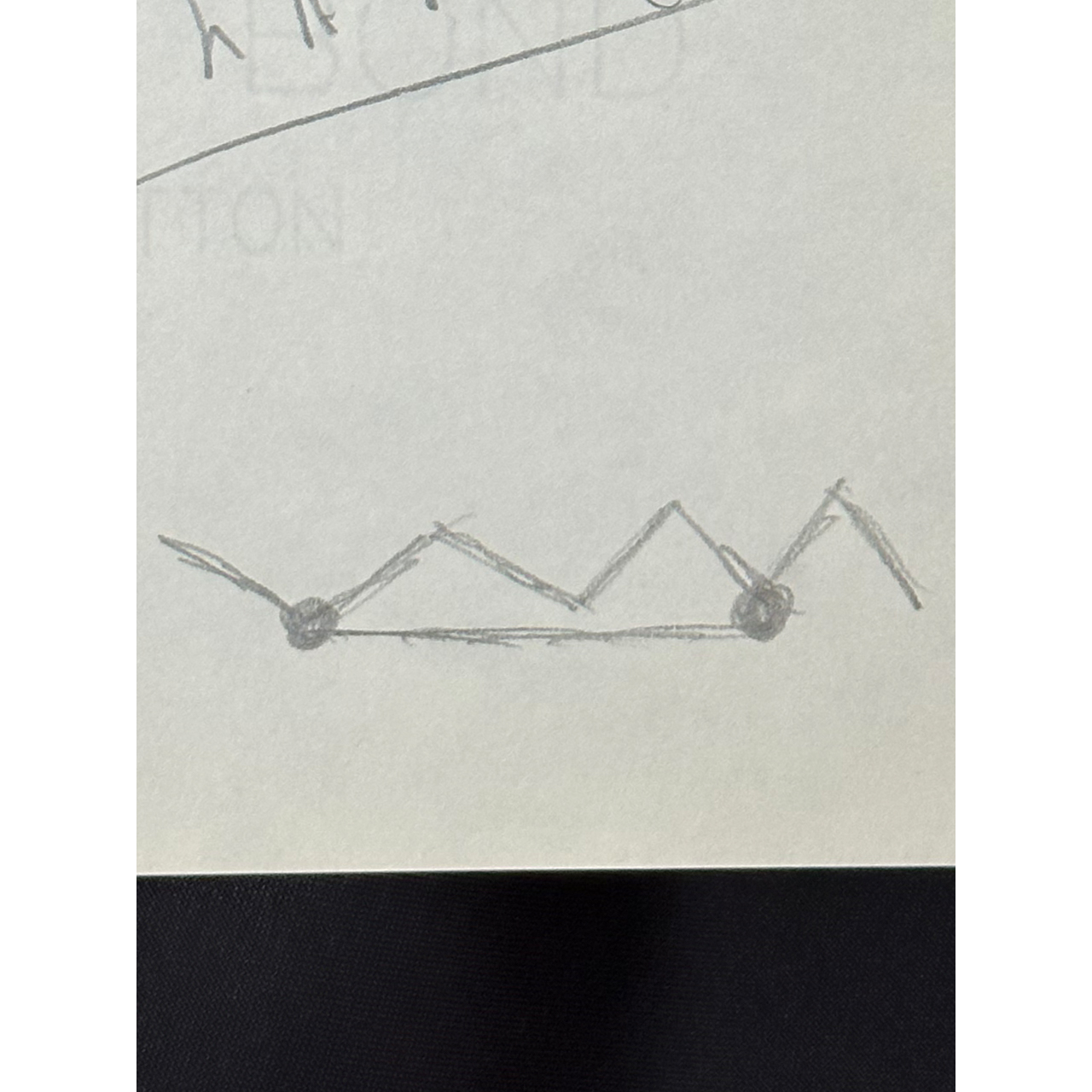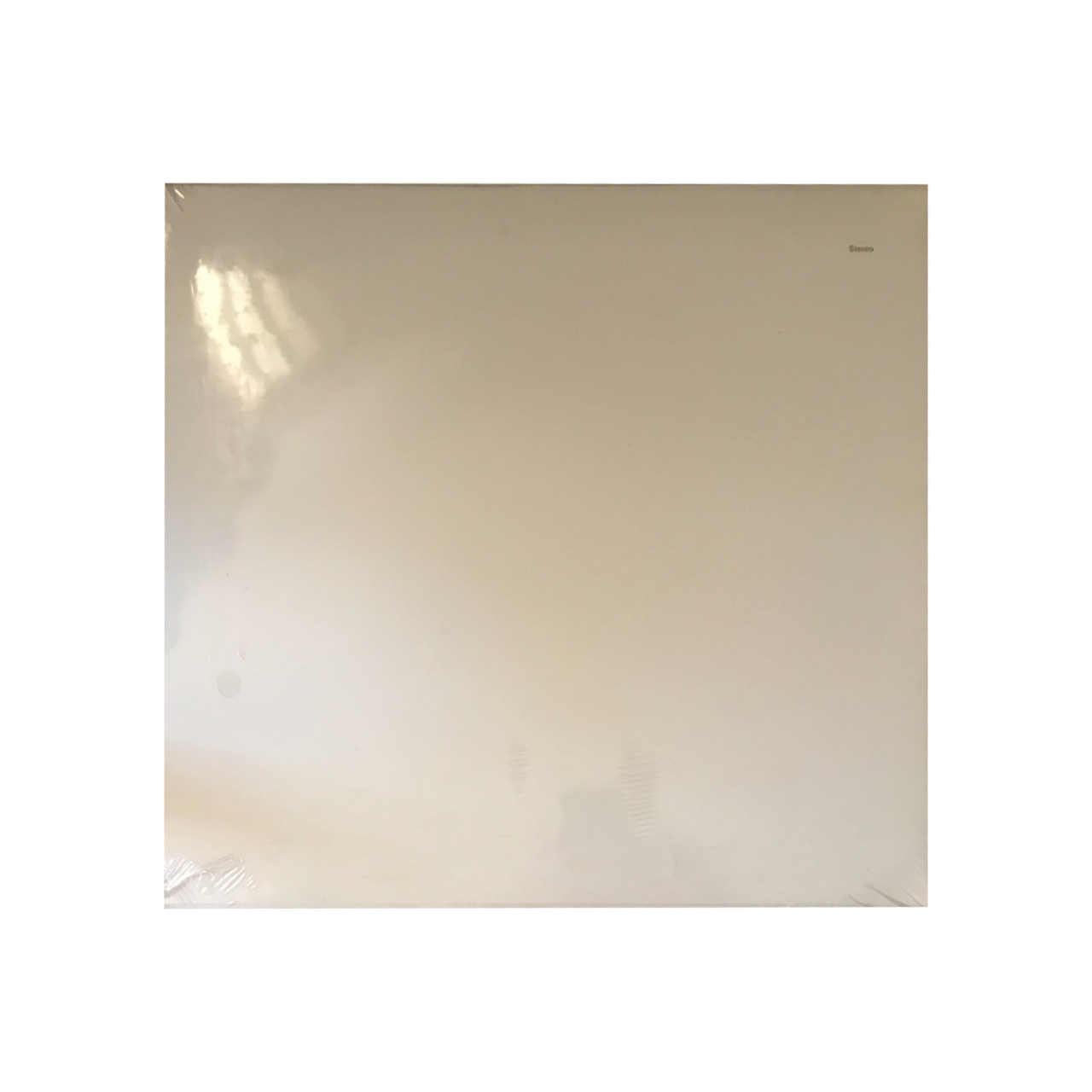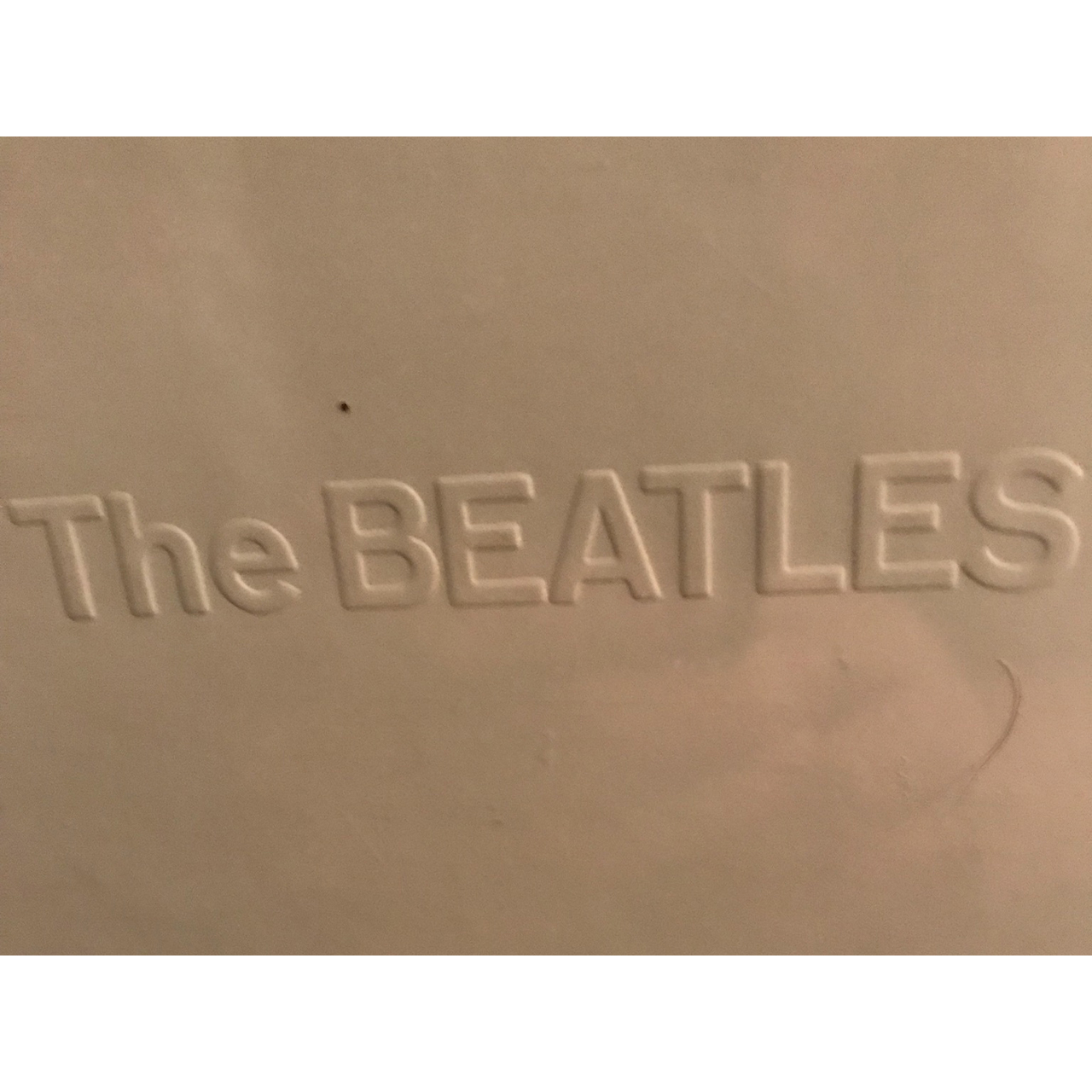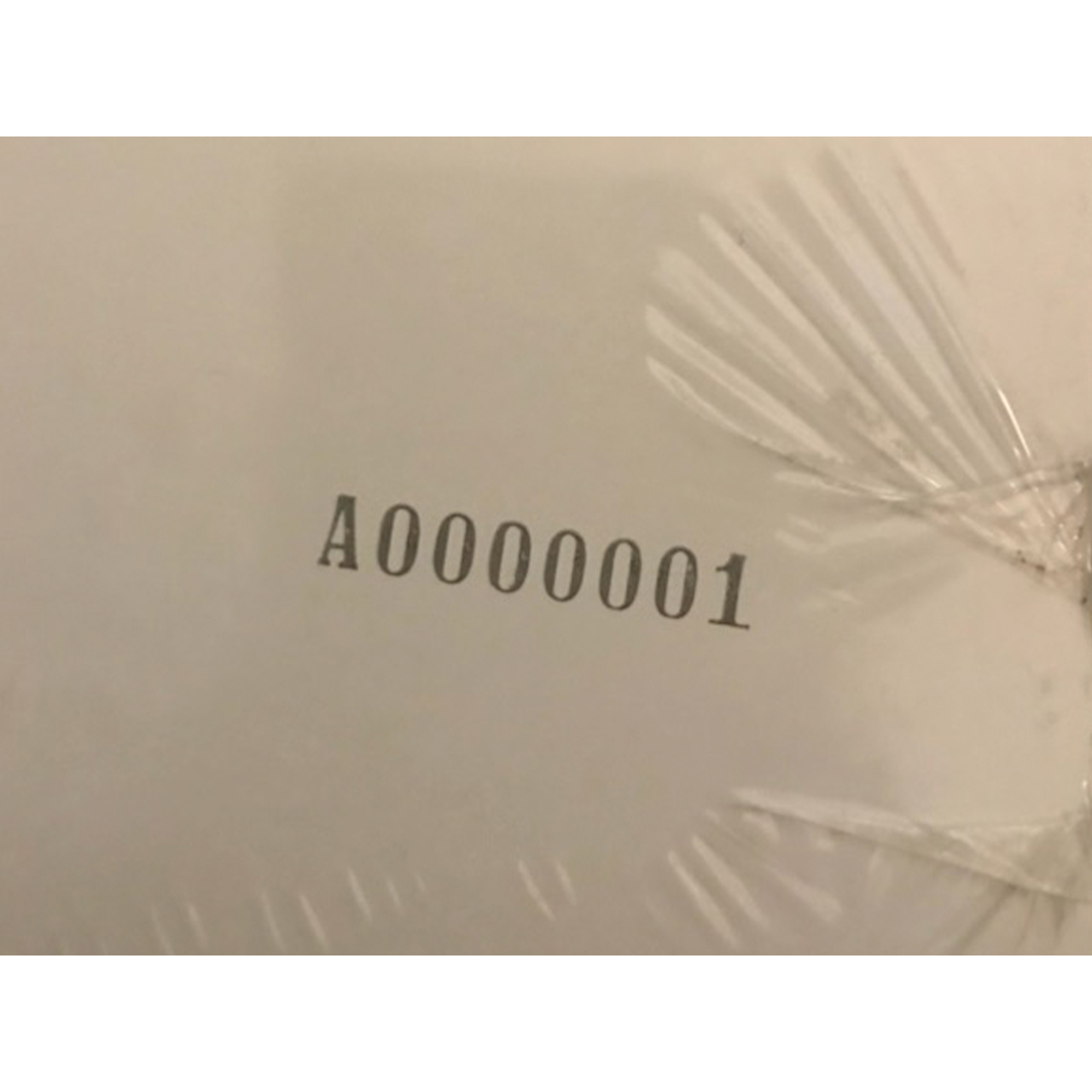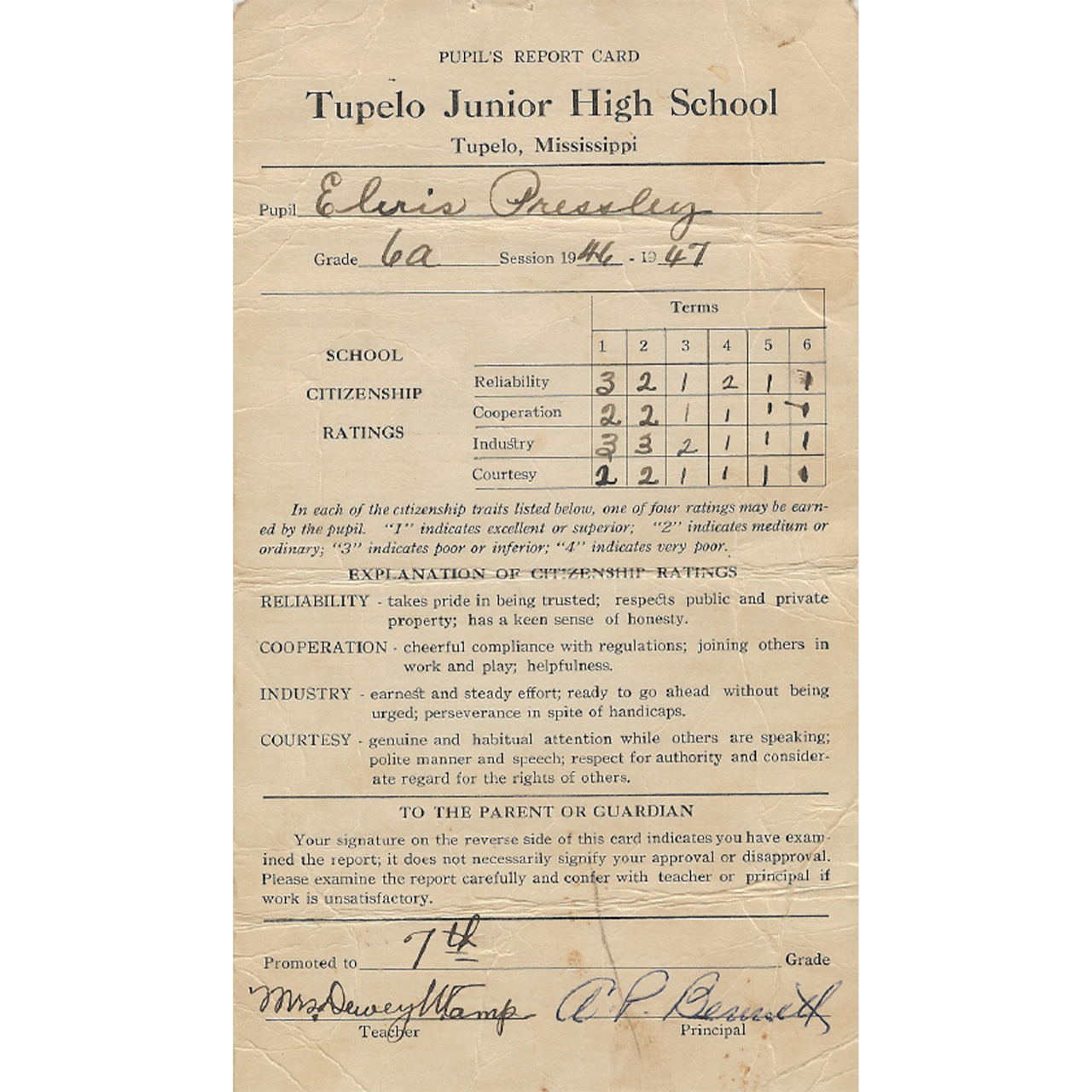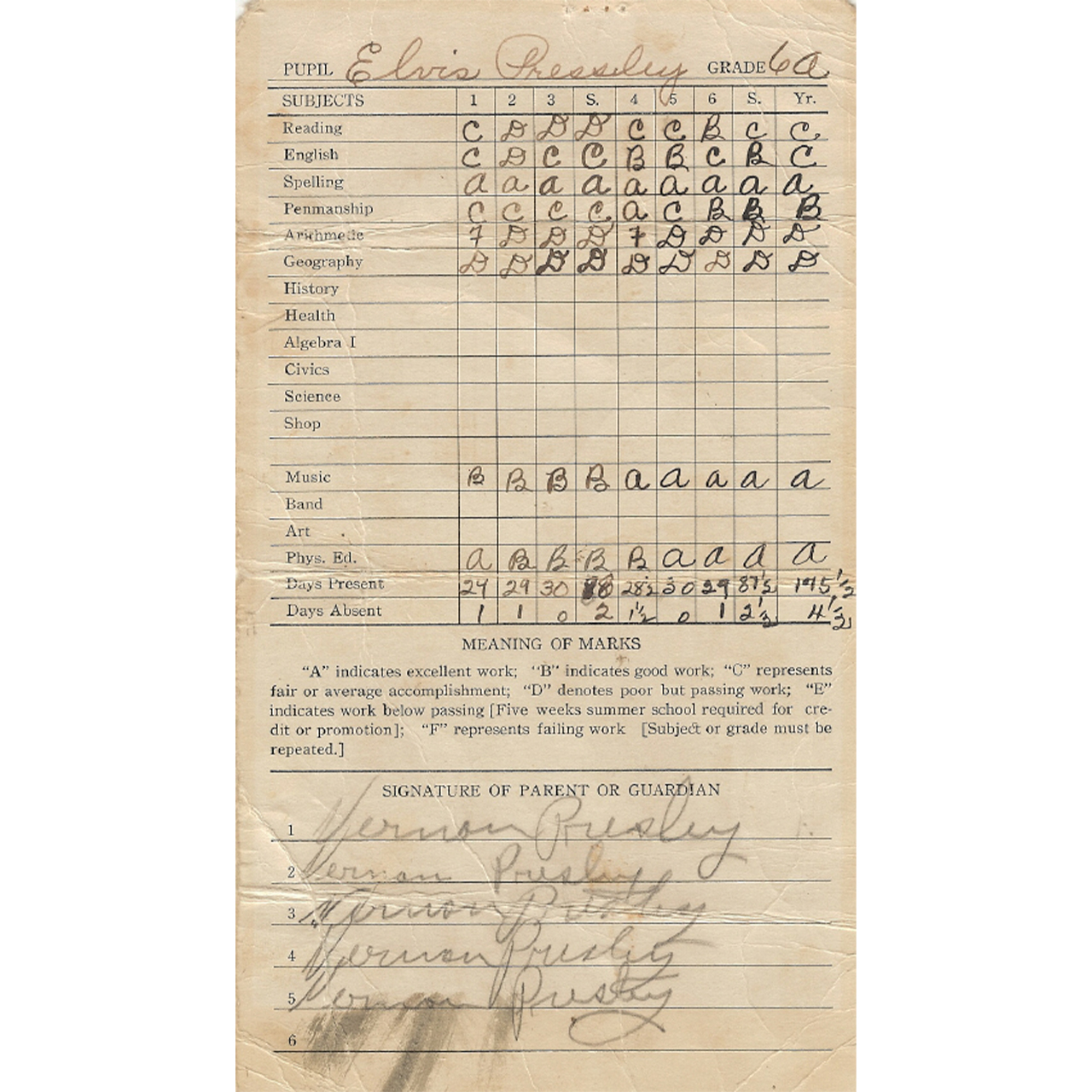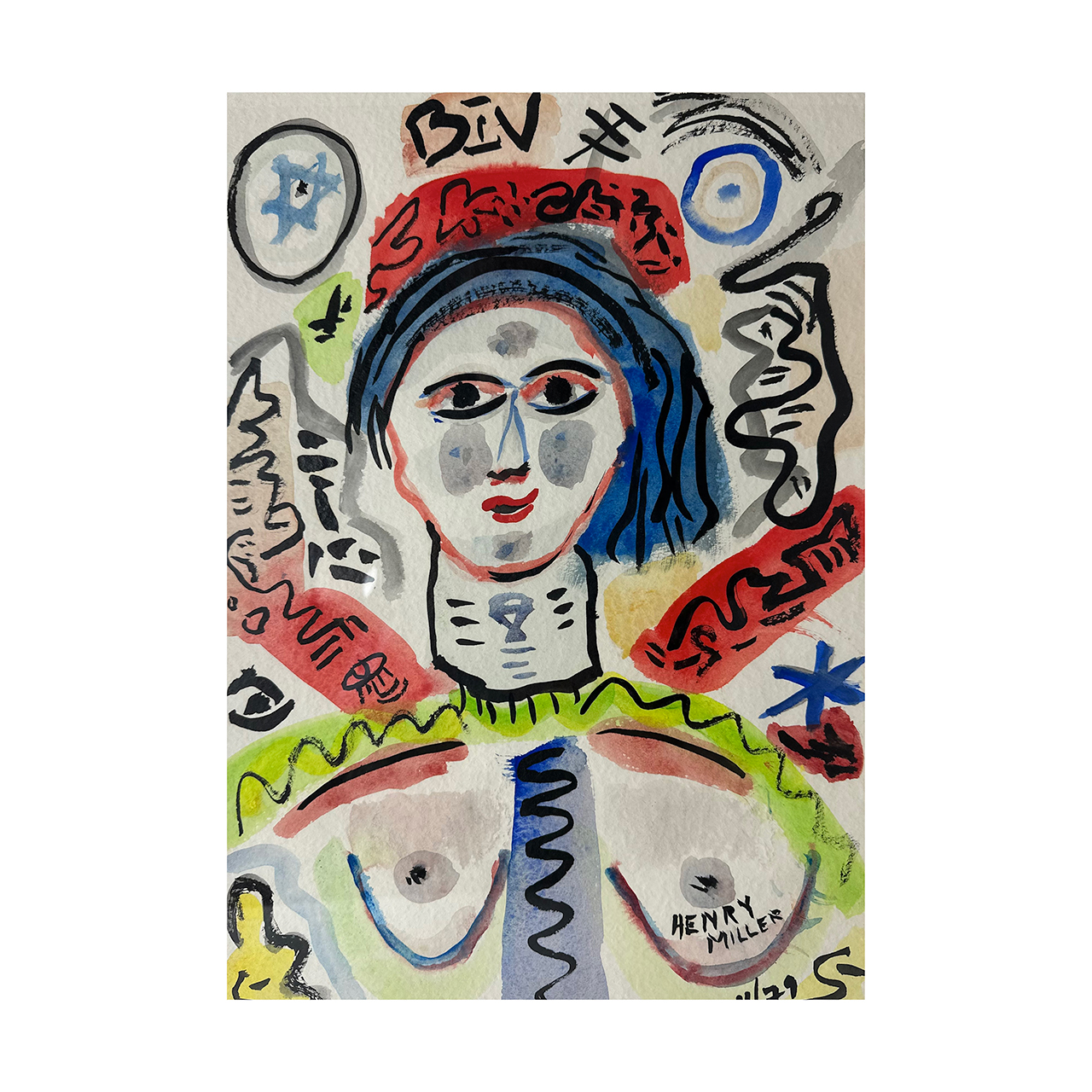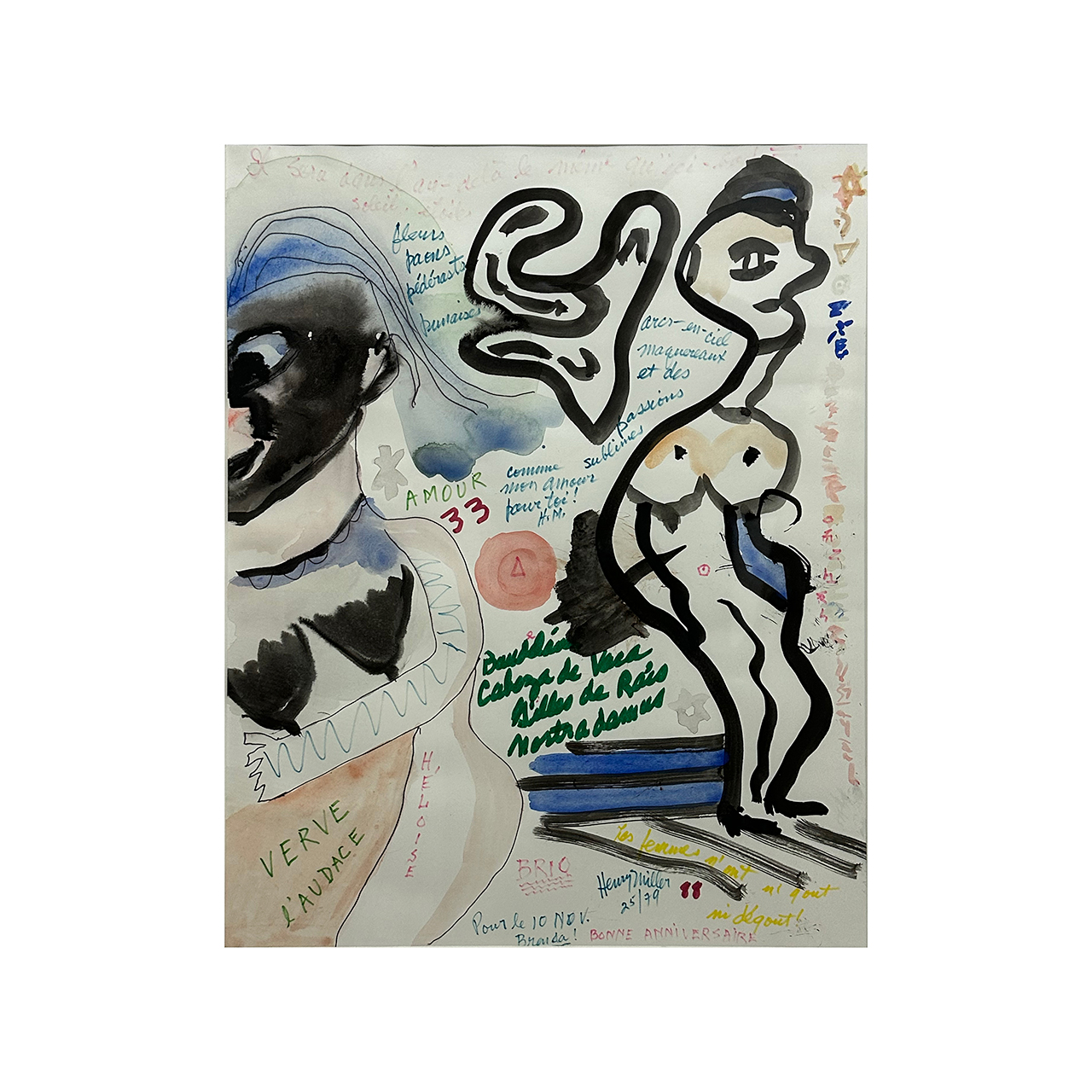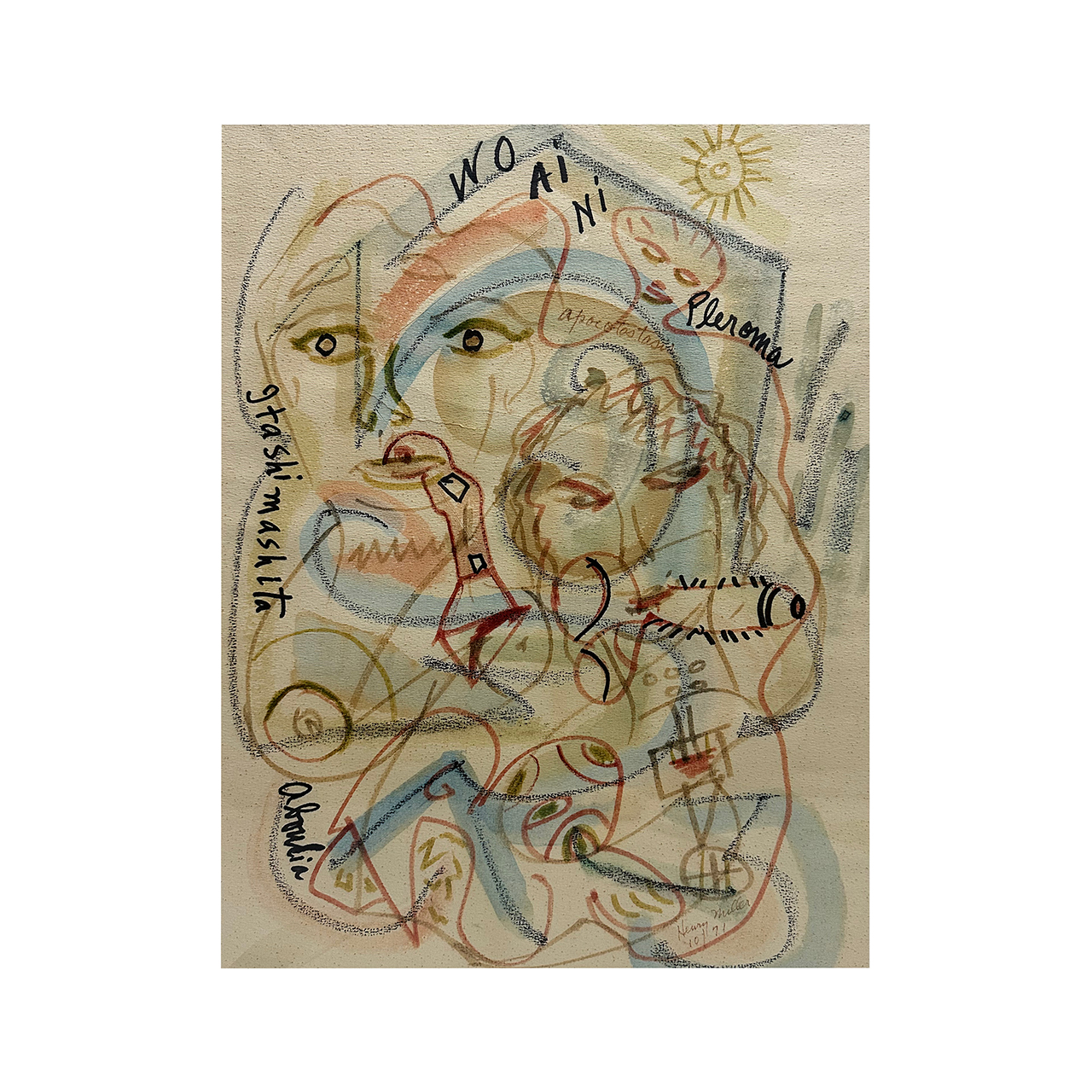December 14th, 2023
Online Auction
By e-mail, mail and telephone
In the decades to come, history books will be filled with the ground-shaking events and landmark achievements of incredibly accomplished individuals that occurred throughout the 20th Century. On December 14, Guernsey's will be featuring at auction a handful of 20th Century treasures that, for those who were alive at the time, are nothing short of extraordinary. President Kennedy's determination to land a man on the Moon, the emergence of Elvis, the Beatles and Bob Dylan, Henry Miller's writing that shocked the world, these and other artifacts to be auctioned relating to these remarkable times follow.
Please click on the links below to see specific items featured in this auction.

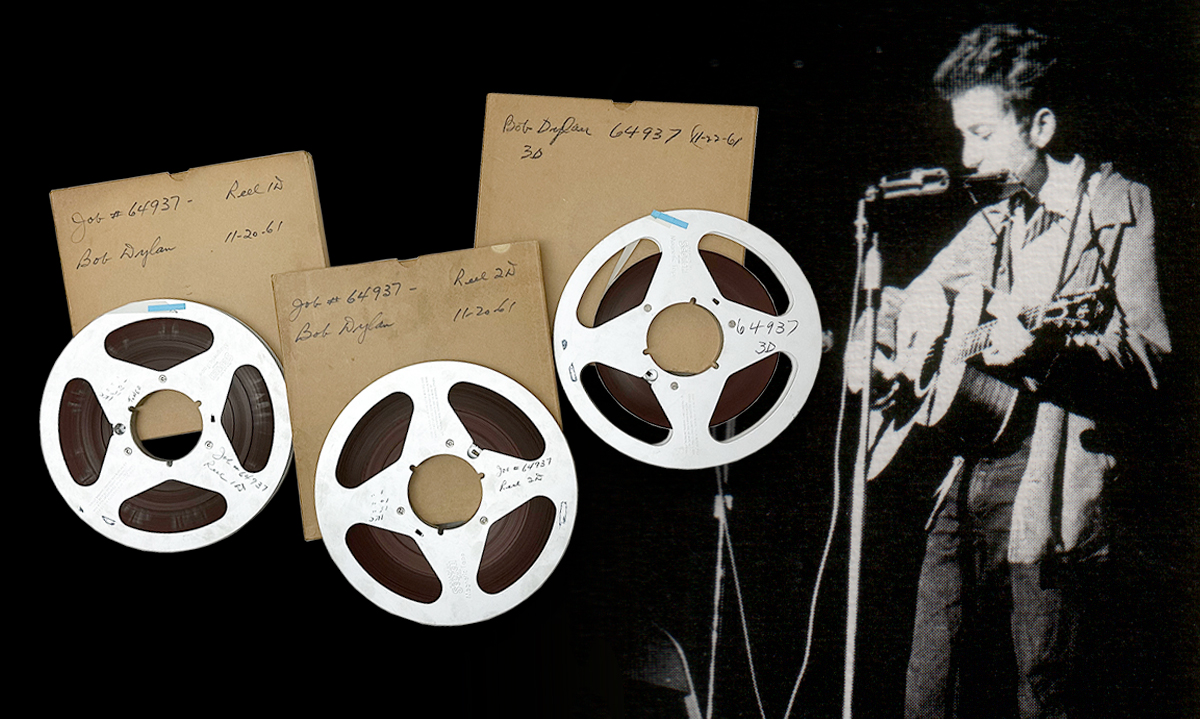
THE MASTER REELS
View on Liveauctioneers.comView on Invaluable.com
Bob Dylan’s Original Recording Session Master Tapes for his first album, “Bob Dylan”
3 Scotch 190 full reels of magnetic 1/2” tape, 10 1/2” diameter metal reels, each with original cardboard slipcase and inner cardboard reel holder. Each slipcase has original Scotch label on one side and handwritten “Bob Dylan, Job # 64937, 11-20-61 1D" on the verso. (“2D" and “3D" are handwritten on the second and third slipcases, respectively.) "Job #64937" also appears handwritten on each slipcase’s narrow end. The reels of tape, slipcases and inner reel holders are in excellent condition. Also included: original tape logs for each reel. Logs list songs, numbers of takes, length, etc. Each signed by John Hammond and initialed by engineer. 1D log has corner tear (no paper loss) and minor paper loss upper right. Logs for 2D and 3D are complete and intact. 3D log has a very minor tear. A professional studio engineer’s recent analysis (see below) of the condition of the tapes has described them as “exceptionally good.” Recently, great care was taken to professionally transfer the analog tape recordings to a high-quality digital format. Also, a plastic leader tape was added at the heads and tails of each reel as protection for the magnetic tape. This was done when the reels were initially inspected and played.
The recordings contained on these three master professional tapes were used to make the first Bob Dylan record album, “Bob Dylan.” Markings on the slipcases and the enclosed tape logs describe the John Hammond-produced sessions at Columbia Studios, New York City, on November 20 and 22, 1961. The dates are consistent with the album liner notes.
The tapes contain all the songs that appear on the album, as well as songs that were not included. Of significant importance is the fact that the tapes also contain verbal comments / suggestions made by John Hammond from the control both and Bob’s responses.
Studio Engineer’s Analysis
On August 7, 2023 at Electrical Audio In Chicago, three vintage master tapes were digitally copied at this studio. The tapes were in pristine condition. Bob Dylan’s first album “Bob Dylan” was produced from these tapes.
The tapes have three tracks running at the recording speed of 15 inches per second. One track is allocated to the vocal and harmonica microphone, another to the guitar and the third (the center track) to John Hammond’s comments over the control room talkback microphone. Accurate playback of the tapes require a tape machine able to handle the three track 15 ips half inch tape format.
The quality of the audio is excellent. A standard practice for making master tapes includes recording a set of tones onto the tapes. Indeed, alignment tones are present here allowing for accurate playback of the masters. They are engineered so that tracks can be balanced or mixed at later sessions. The engineers established their recording levels during Dylan’s first run “You’re No Good.” These are professionally formatted, first generation tapes; from a pure audio quality perspective, they are the best.
Regarding audio quality, starting at approximately halfway through reel “2”* and continuing through reel “3,” a low level noise is discernible. It was detected and indicated on the tape logs. It is speculated that this came from John Hammond’s center track. (*It is quite possible that this was at the start of the second day of the two-day recording session.)
It should be noted that it was often the practice to make valuable master tapes redundant. If a tape was lost or damaged, a back-up existed. Studios could make multiple masters by recording simultaneously on two aligned recorders. Inasmuch as each reel number designated on these tape boxes ends with a letter “D” (i.e., 1D, 2D, 3D), these tapes could possibly be duplicates. If this is true, it would therefore be possible that another set of Dylan masters for this album exists. Research, however, into this possibility has not revealed such additional tapes.
History
John H. Hammond was a record producer, Civil Rights activist, and talent scout. He was considered one of the most influential figures involved in mid-twentieth century music. Mr. Hammond played a significant role in the musical careers of such figures as Bruce Springsteen, Benny Goodman, Billie Holiday, Count Basie, Pete Seeger, Aretha Franklin, Leonard Cohen, and many others. Perhaps of greatest significance was John’s discovery of Bob Dylan.
On November 20 and 22, 1961, John Hammond produced two recording sessions with Bob Dylan at Columbia Studios, NYC. From those sessions came Bob’s first album titled simply “Bob Dylan.” Although the album was far from a financial success, it universally has been credited for initiating Bob Dylan’s remarkable and unprecedented career. Stemming from this album, Bob Dylan’s words and music have impacted the lives of several generations of people around the globe.
Ownership
Stephen Handschu, current owner of the Bob Dylan tapes, is a remarkable person. Blind since birth, Stephen nevertheless has long been an activist for Civil Rights and other just causes. Stephen has been instrumental in the placement of Braille books in libraries across the U.S.
When Stephen was a young man in the early 1960’s, he lived and worked in a lower Manhattan studio. Despite being blind, he was recognized for his sculptural work in wood. In 1966, Stephen’s roommate who worked as a custodian in the building where Columbia Records studio was located, was allowed to take tapes from the studio that were otherwise destined to be discarded. Inasmuch as it was customary that old tapes were scrubbed, it was believed that these tapes were blank. The roommate gave the tapes to Stephen because of his interest in all things audio.
Leaving NYC, Stephen kept the tapes. Fast forward nearly four decades. While living in Chicago, Stephen Handschu was introduced to Scott Steinman, chief studio engineer and studio owner. Together, the men were making a recording to help blind people vote. It was only then that Stephen mentioned that he was in possession of a set of old master reels of tape. Interested, the studio head arranged for an old tape player to be rigged up. Shockingly, always having believed that the tapes had been scrubbed (erased while at the studio, the two men heard Dylan’s unmistakable voice. The rest is history.
And now...
Twenty years after the stunning discovery, earlier in 2023 Stephen learned of a new television program being launched. Similar to the Antiques Roadshow, it was to focus on entertainment memorabilia. So excited were the Show’s producers to hear about the discovery of the Dylan tapes, they allocated half of a segment to it. Airing on DirectTV May 1st of this year, in addition to a Rock & Roll historian, the Show featured an interview with John Hammond, Jr., who - as the son of the producer - was present at the Dylan 1961 recording session. All concluded that indeed, these tapes were genuine.
Today, Mr. Handschu lives in Detroit where he has been a tireless advocate for the blind and otherwise disabled. Most thoughtfully, though not a man of substantial means, Stephen Handschu will be donating a portion of the proceeds from the sale of the Bob Dylan tapes to Eye Learn Cares, the only non-profit organization to helping the Blind in Detroit.
AUDIO CLIPS FROM THESE RECORDINGS
Bob Dylan and producer John Hammond’s recording session’s conversationsRecord producer and civil rights activist John Hammond was responsible for discovering an extraordinary array of the twentieth century’s most popular performing artists. A partial list of those who largely owe their careers to Hammond include Benny Goodman, Count Basie, Billie Holiday, Robert Johnson, Bessie Smith, Aretha Franklin, Pete Seeger and Bruce Springsteen.
On November 20 & 22, 1961, John took a young Bob Dylan into the Columbia Records, NYC recording studio. From those sessions came more than four hours of tape footage and the birth of a legendary career. Titled simply “Bob Dylan,” the album that resulted from those two sessions was far from a commercial success. Nevertheless, it is universally recognized for bringing attention to a man whose words and music powerfully impacted a generation.
As one would imagine, there are multiple “takes” for each of the thirteen songs that ultimately appeared on the three-track album. Fortunately, one of those tracks recorded the control room microphone through which John spoke with Bob. Recorded for posterity - and being heard for the first time though this Guernsey’s offering - is the interesting banter between the producer (Hammond) and the artist (Dylan) as they discuss what the folksinger has chosen to perform. It is certainly interesting to note how young indeed Bob Dylan sounds, and that the selection of the songs for the album was made entirely by Dylan. Unlike today, it seems like little concern was given to such matters as “copyrights.”
Below is just a sampling of the many sound clips (and their transcriptions) of Bob and John on these master tapes.

Audio Clip #1:
*Dylan singing “Man of Constant Sorrow"
John Hammond: What was the name of that, Bob?
Bob Dylan: “Man of Constant Sorrow.” Did you get that?
Hammond: Sure I did, it’s all right. Who wrote that?
Dylan: I don’t know.
Hammond: Has it been recorded?
Dylan: Not that way.
Hammond: How has it been recorded?
Dylan: A different way, I guess.
Hammond: Who did it?
Dylan: Judy Collins, but not a version like that. That’s a different one. Judy Collins on Electra.
Hammond: On Electra. We’ll find out from Electra who wrote the damn thing.

Audio Clip #2:
*Bob Dylan singing “In My Time of Dyin’"
John Hammond: That is great. I’m going to make an announcement on that because that’s the master right there. All right 68733, just proceeded take one
Bob Dylan: Do you want me to do that again?
Hammond: No, you don’t have to. That’s it. Who wrote “In My Time of Dyin’?
Dylan: I don’t know. Who wrote that?


JFK'S MOON NOTE
View on Liveauctioneers.com
View on Invaluable.com
In this historically compelling note, Kennedy sketched a small sailboat in the upper right corner.
He then wrote the words, “Space Race – Man walks on Moon before 1970,” underlining the year. JFK
then wrote and boldly framed the word NASA in capital letters. He concluded with an odd doodle of
three triangles with two circles. One cannot exemplify enough the chronicled essence of this piece
with respect to mankind’s greatest accomplishment in world history; a remarkable feat by a beloved
martyred president.
In 1961, President John F. Kennedy began a dramatic expansion of the U.S. space program and
committed the nation to the ambitious goal of landing a man on the Moon by the end of the decade. In
his address to the Joint Session of Congress on May 25, 1961, President Kennedy stated: "First, I
believe that this nation should commit itself to achieving the goal, before this decade is out, of
landing a man on the moon and returning him safely to the earth." This historic speech would change
the course of history and set the United States on a mission to put a man on the moon by the end of
the 1960s. Again, on September 12, 1962, in his address at Rice University,in Houston, Texas the
President emphasized the necessity for the United States to become an international leader in space
exploration. In that speech, Kennedy characterized space as a new frontier, infusing his speech with
a sense of urgency and destiny and famously said, "We choose to go to the Moon in this decade and do
the other things, not because they are easy, but because they are hard."
From the Michael J. Kirwan Collection. Michael Kirwan was an American politician who served as a
Representative to Congress from 1937 until his death in 1970. Kirwan forged a strong
friendship/mentorship with a young Jack Kennedy during Kennedy’s years in Congress, first as a
Representative and then as Senator. Kennedy and Kirwan were both devout Catholics and of proud
Irish-American heritage. They were good friends from January 1947 to November 1963. Among the
highlights of Kirwan's later career was an event held in his honor at Youngstown's Idora Park
Ballroom. The keynote speaker at that event was U.S. Senator John F. Kennedy, who would run
successfully as the Democratic presidential candidate the following year. The bond continued
throughout Kennedy’s presidency, with Kennedy supporting many of Kirwan’s conservation causes, and
as fellow Irishman with Kennedy including Kirwan when he hosted the Ambassador of Ireland at the
White House, and attending Kirwan’s annual St. Patrick’s Day celebrations. As personal secretary to
Kennedy during both his Senatorial and Presidential years, Evelyn Lincoln often reminded Kennedy to
pass on his doodles and unofficial documents to his friend Kirwan. Upon Michael Kirwan’s death in
1970, his widow gifted his collection to presidential historian, John Burke Jovich.

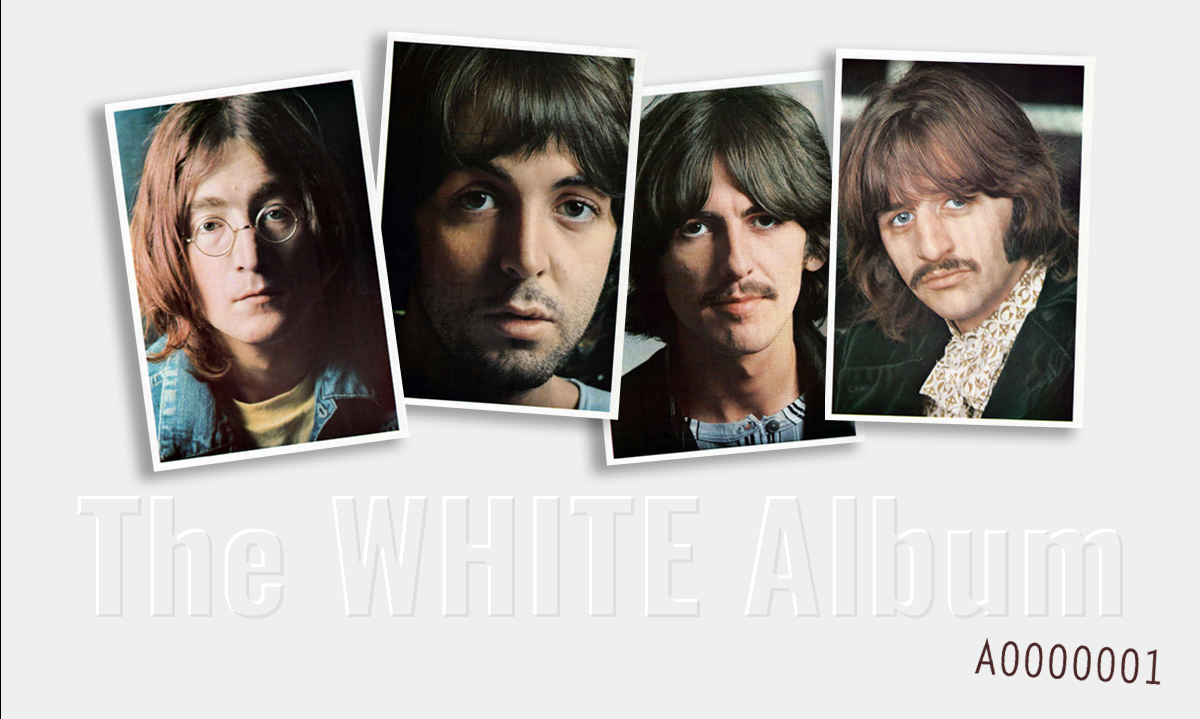
THE ONLY KNOWN FACTORY SEALED NUMBER A0000001 BEATLES WHITE ALBUM
View on Liveauctioneers.comView on Invaluable.com
In mint condition; the only known factory sealed number A0000001 Beatles White Album in pristine
condition. As such, this is quite possibly the rarest Beatles album in existence.
The “White Album" was the Beatles last album released on Capitol Records and the first Beatles album
for Apple Records. A double album, it was released on November 25, 1968. First issue covers had the
title “The BEATLES” in raised letters, the covers were numbered and the discs had an Apple label
with a Capitol Records logo in white around the perimeter. Later issues were not numbered and the
discs also lacked the Capitol Records logo. Each album was issued with two discs, a large poster and
four glossy photos: one of each Beatle. First issues also included a color protective sheet.
The history / provenance of this factory sealed A0000001 White Album is as follows: This copy is
believed to be one of only three Number One "White Album" covers that were made at the Queens Litho
company which supplied the covers for Capitol/Apple Records during the production of this album. It
was owned from new by a Queens Litho employee who had worked on the project. In 1998, on behalf of
that employee, the respected Beatles authority Perry Cox sold this particular copy to its current
owner.* In Mr. Cox’s Letter of Authenticity, he describes in detail how this album was one of the
three created at the time, and believes it to be the only one that was factory sealed. The other two
were believed to never have been sealed. Additionally, there is a “Letter of Appraisal” by
accomplished Beatles collector and dealer Steve Green. (*The current owner, who has been in
possession of this album since 1998, is recognized as an advanced collector, an expert on Beatles
vinyl and is the author of published literature pertaining to these recordings and their worth.)
There are no discs inside the album. It should be noted that this Beatles White Album is known as a
"presentation copy;” as such, it would not have been sold to the general public nor would it have
contained discs. By shifting the album back and forth, there is the sense that the poster and four
photographs of the Beatles that came with the album are indeed inside.
Condition: this White Album, A0000001, was sealed in 1968 at the factory at the request of a company
executive. It remains in near-mint 9.8 condition! The cover is absolutely pure snow white, and
inasmuch as there are no record discs inside, there is no record impression nor wear due to a
record. The corners remain sharp; the clear wrap is intact with areas showing the bunching effects
of heat sealing. There is a tiny indentation top center on the cover near the seam.
Several years ago, this extremely rare album was about to be sold at auction when the auction house
at the time received a concerning query questioning the authenticity of the original sealed
wrapping. With the question raised, the album was removed from the event. When the person raising
the question was satisfied, that person wrote a retraction, but the opportunity to have sold the
album at that time had passed. In July of 2023, Goldmine Magazine ran an article about this rare
White Album. A copy of this letter can be viewed at your request. This extraordinary, sealed Beatles
White Album will be sold at auction for the first time this coming December 14th.
Several accomplished collectors that this auction house has approached believe this could possibly
be the only opportunity to acquire a sealed, pristine example of one of the most sought-after
Beatles collectibles.
Letters of endorsement from accomplished Beatles collectors and experts (Perry Cox, Steve Green,
John Tefteller, Jim Kaysinger, ect) can be viewed here.
A meaningful and important video from the owner of this album can be seen here.

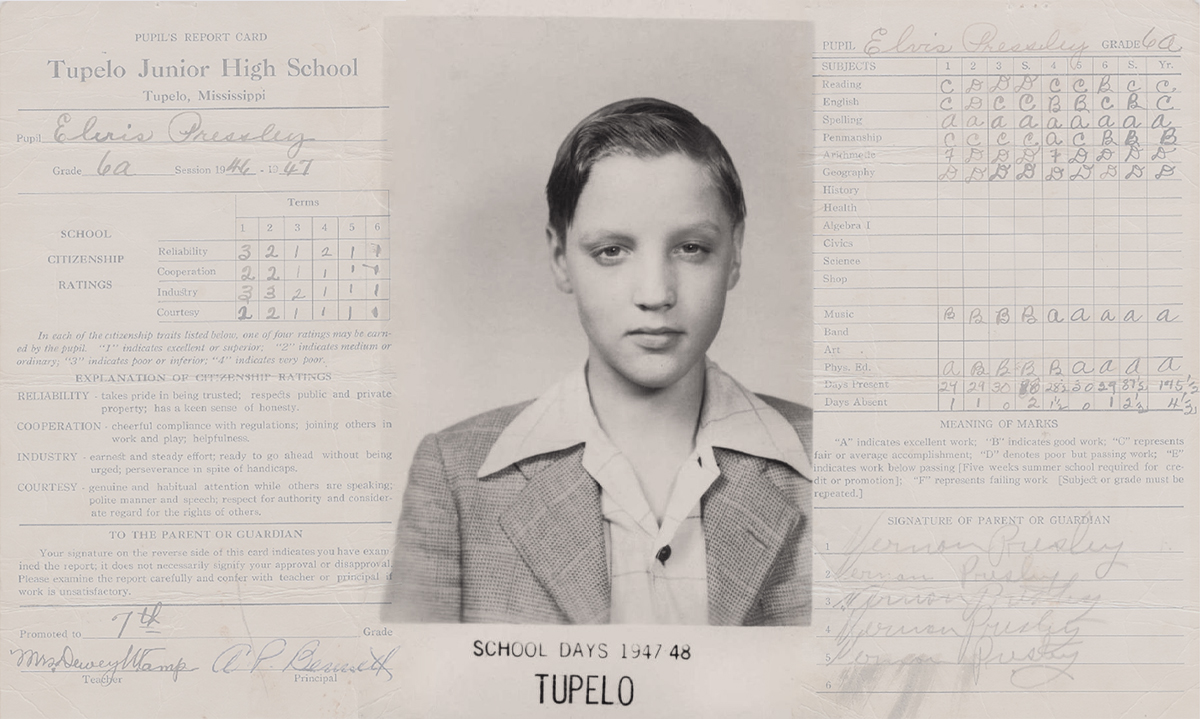
ELVIS'S REPORT CARD
View on Liveauctioneers.comView on Invaluable.com
Elvis Presley’s 6th Grade Report Card from Tupelo Junior High School
Double-sided faded white paper
8 x 4.5 inches
14.375 x 11.25 inches framed*
In October, 1999, working closely with Elvis Presley Enterprises, Inc., Guernsey’s held an auction
of over 2,000 items from Elvis Presley's Graceland Archives at Las Vegas's MGM Grand. The auction
benefited Presley Place, a transitional housing development located in Memphis, Tennessee. Included
in the auction were garments owned and worn by Elvis, automobiles, furniture, documents related to
his career, including contracts and correspondence. The very first item, listed as item A-1, was
Elvis' 6th grade report card that is presented here. Starting with this lot, the excitement and
vigorous bidding it generated continued throughout the lively and joyful three-day event –
underscoring Elvis’ unique position in 20th century culture. The event was described in the press as
“the most extraordinary auction of items relating to the popular culture ever held.” Almost thirty
years after his death, Elvis remains one of the most well recognized, popular figures of Twentieth
Century. Collecting material related to the entertainer has been described as the current “leading
hobby on earth.”
Elvis attended Tupelo Junior High School during the 1946-1947 school year. While Elvis earned
straight A's in spelling, his teacher was less than excellent in the subject. Mrs. Dewey Camp
misspelled his name as "Elvis Pressley" on the report card. Elvis received D's in Arithmetic and
Geography, but not surprisingly, he ended up with an A in music. The moral of this story is that you
don't have to be excellent at everything, but you need to be excellent at something.
Side 1:
Headed “Pupils Report Card / Tupelo Junior High School / Tupelo, Mississippi”
Issued to “Elvis Pressley” [sic]; Grade 6a; Sessions 1946 to 1947
This side of the report card lists “School Citizenship Ratings” with grades from 1 (excellent to
superior) to 4 (very poor) for Reliability, Cooperation, Industry, and Courtesy for each of the six
grading periods of the school year. Elvis apparently got off to a rocky start with grades of 3 (poor
or inferior) in Reliability and Industry, and grades of 2 (medium to ordinary) for Cooperation and
Courtesy for the first grading period. It is evident that young Elvis Presley did straighten out by
the end of the year, with all 1’s for his final grading period.
Side 2:
Headed with “Elvis Pressley [sic] / Grade 6a”
This side lists regular school subjects, with grades written in ink for each grading period. Elvis
was strong in Spelling, earning straight A’s for the year. He also did well in Music and Phys. Ed
with a mixture of A’s and B’s. Elvis struggled with Geography and Arithmetic, getting all D’s for
the former and a mix of D’s and F’s for the latter. Elvis’ grades for English, Reading, and
Penmanship were a mixture of A’s, B’s, C’s, and D’s. He is listed as being absent 4 ½ days our of
the 180-day school year.
Elvis was remembered by Tupelo classmates as a loner who didn’t really fit in well. The Presley
Family left Tupelo and moved to Memphis in the fall of 1948.
Includes Certificate of Authenticity from Elvis Presley Enterprises, Graceland
YouTube Video of Elvis in the 6th grade
at Milam Junior High, Tupelo MS
Provenance:
Graceland Archives
The Elvis Auction: Guernsey's, October 8, 1999, Lot #1
Private Collection


EDDIE VAN HALEN'S GUITAR, GIFTED TO JASON BECKER
View on Liveauctioneers.comView on Invaluable.com
When it comes to guitar legends, no one would question the extraordinary talents of the late Eddie
Van Halen. Fewer, however, will know of Jason Becker, the sixteen year old phenom who exploded on
the Rock scene in the mid 1980’s only to contract ALS by the age of twenty. Although Jason continues
composing music (by using his eyes in a system developed by his father), his days as a lead
guitarist were short. But two albums (produced with his friend Marty Friedman) and stints with David
Lee Roth cemented Jason’s place forever in the world of Rock greats.
Several years ago, this auction sold the three instruments Jason himself played. The proceeds from
that sale have gone a long way in easing the life of a man, now in his fifties, forever burdened by
his crippling disease. But demands are such that we are now offering Jason’s most treasured
instrument - Eddie Van Halen’s personal Peavey EVH Wolfgang guitar.
While Eddie was known to have greatly admired the work of Jason for years, on August 31, 1996 the
two men met for the first time when Van Halen visited Becker’s Southern California home. In a video
(linked below) recorded by Jason’s parents, Eddie Van Halen played a section of Eruption (as well as
other tunes) on the guitar before handing it over to the wheelchair-bound artist. He then inscribed
the instrument: “Jason. We will play guitar together in the future. Love - from heart to your soul.
Eddie Van Halen, ’96.” The two men remained close friends through the end of Eddie’s life.
Production of the Peavey EVH Wolfgang signature guitar (named after Eddie’s son) had just begun at
the time of the gift. Jason’s instrument, designated #69, had been culled from the first 100
examples of the model that were made after Eddie tested each one and selected a handful that he
deemed best for his personal use. Once selected, the guitar was re-inspected and set up by Jim
DeCola, Peavey Guitar Design Engineer / EVH Wolfgang Designer. Jason Becker’s thumbprint now appears
on the back of the neck, reflecting its ownership by two true guitar icons.
The instrument comes with an original Certificate of Authenticity and, should the buyer wish, an
opportunity to meet with Jason Becker.



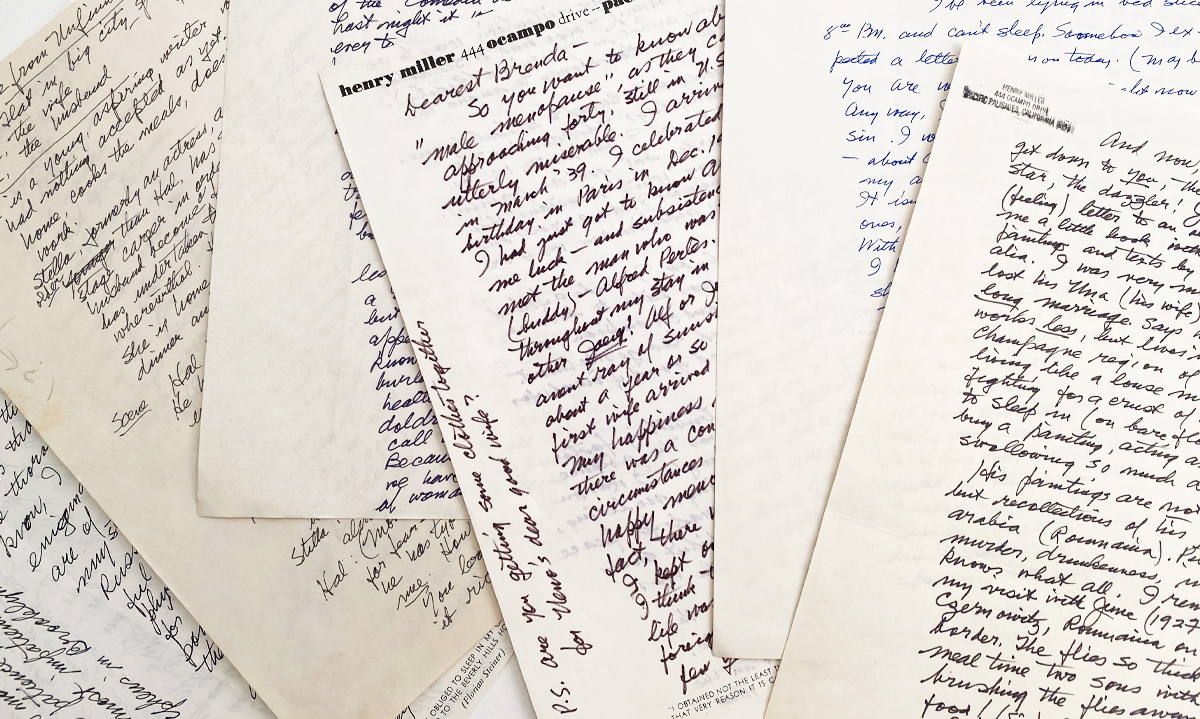
HENRY MILLER'S 500 REMARKABLE LETTERS
View on Liveauctioneers.comView on Invaluable.com
A stunning collection consisting of over five hundred original handwritten letters on approximately nine hundred and fifty pages, written by Henry Miller, then in his eighties, to Brenda Venus.
Many are multi-page letters, some of which are written on two sides of the paper Most of the paper is Mr. Miller’s letterhead with his name and Pacific Palisades address appearing printed upper left. Occasionally, printed quotes (by Henry Miller and other writers) appear on the bottom of the pages.
Ms.Venus was becoming known for her beauty (Miss Texas, Playboy Magazine centerfold, actress and dancer), and was also quite interested in American literature. It was this interest that led her to meet the elderly Mr. Miller. What ensued was a passionate exchange of letters (along with occasional physical encounters) that spanned 1976 - 1980, culminating with Mr. Miller’s passing. Mr. Miller, then in his eighties, wrote explicitly of his love, desire and lust for Ms. Venus. (Although the collection contains only a few of her written responses, the two clearly shared similar emotions despite their 60 year age difference.)
Most of the letters include lengthy passages of love and explicit visions of sex. Importantly, they also are filled with Mr. Miller’s thoughts about the world, about growing up (in an anti-Semitic Brooklyn neighborhood), life as a young writer living amongst Parisian prostitutes (while penning Tropic of Cancer), the free press, influences, great books, films and music, friends (many of whom, he points out, are great Jews), enemies, and countless other topics and opinions. Embedded in the letters are assorted lists, poems and a lengthy scene from a play Henry Miller was writing.
Exerpts from a number of these latters appear in Ms. Venus's 1986 book Dear, Dear Brenda
QUOTES FROM THIS LETTER COLLECTION
- "...I shall soon be made a member of the Legion of Honor. In Paris the prostitutes demonstrated against the award, saying I treated them unfavorably, whereas I thought I had done very well by them. And here the Women's League protested at the French Embassy in Wash, D.D. - "I am a dirty chauvist pig." say they. The truth is just the contrary. I love women and consider them superior to men."
- "Have you seen any of Lina Wertmuller's films? Swept away, perhaps? There's a woman I admire, as I do Germaine Greer. Both more frank, more daring more courageous than most men. And both extremely capable. Lina, in my opinion is a better director than any man. When I saw "Swept Away" I was reminded of "Tropic of Cancer" and "Sexus."
- "Utter degradation with no loss of nobility! We all need to know suffering together, as after a quake of disaster. Then it's possible to bear up under the blow! Communism versus true religiosity!"
- "Coppola never showed up. At the last minute his girl friend phoned to say he had to meet Marlon Brando before taking the plane to the Philippines. Brando doesn't like the script and Coppola had to appease him one way or another. So - fuck Marlon Brando!"
- "… let me tell you of a little incident some few years ago in Paris, after the publication in French of Sexus. All of a sudden the French authorities decided that they would take no more of my nonsense. They threatened me with imprisonment, imagine that!"
- "There I was summoned with my French lawyer. After quite a bit of questioning the judge leaned over his desk and, gazing at me, severely said - "Monsieur Miller, there is one last question I must ask you. Please pay strict attention. The question was - Do you honestly believe a writer has the right to say anything he pleases in a book? I took a few studied moments before replying and then I said calmly but with conviction - "I do, Your Honor?"... Now the judge came down from his dais, hugged me, kissed me on each cheek ("the accolade") and said "You belong with the immortals: Francois Villon, Baudelaire, Zola, Balzac etc etc. I salute you!""
- Referring to Lina Wertmuller: "She was lucky enough to have a great master of the films - Fellini! We have no such animal in this country. Also she was lucky to be so homely; she didn't have to fuck everybody who came along on her way up."
- Referring to his 17 years in Big Sur: "As I often say - it was one of the four Paradises I have known: 1.) The 14th Ward, Brooklyn. 2.) Paris. 3.) Greece. 4.) Big Sur. I had sea, mountain, and forest - what a divine combination. I came there as a man who had never lived in the country before. It was all new to me. I communicated with the stars and distant friends. Telepathy! My intuition thrived. I wrote like a fiend..."
- "The French are extremely witty, clever, insolent, arrogant, not "romantic" in the least. It's we "materialists" who are romantic and foolish (Les Americains)"
- "When I was waking up a few minutes ago I found myself writing in my head. The strangest thing. I was dead and just realized that I was in Devachan (the realm between death and rebirth). My mother is coming toward me looking radiant. She seems very young. "O Henry," she begins, "I have waited for you so long. What kept you on earth all this time?" (This is the first time I hear my mother murmer endearing words.) I am choked with emotion. "Mother"... is all I can say. And then I discover that the tears are running down my cheeks."
- "I have my limitations too, you know. I'm only Henry Miller."
- "…this is my farewell not only to American but to the planet itself. I don't want to be reborn on Earth - I will wait until I find a planet a universe to my liking. That is, when I get to this limbo between life and death."
- "Today the little book I wrote in French came in the mail - the first copy. It was full of printer's errors which made me furious. Did I ever tell you the title? "J'suis pas plus con qu'un autre." Which means, freely translated, "I'm no more a shit-heel (con) than the next guy." Hardly a word in it about sex. Mostly about old books and authors, both English and French."
- "Olivier is the actor personified - everything thought out. But there have been lesser figures, in the cinema, who I find more intriguing. Of course I must admit immediately that my favorites are Emil Jannings (in "The Blue Angel" and "The Last Laugh") and Raimu, the French actor, who could weep openly like only a real man can.... Burton makes we weep when he recites Shakespeare - because he is Welsh, I think. The Welsh are born poets. I know Dylan Thomas in London. He wanted me to go back to Wales with him. Offered to let me sleep with his sister."
- "I have never been afraid of death - only dying. I fully expect to die one day or night while sound asleep with arms crossed and a smile on my lips. (As a man should go, damn it!)"
- "Good as it all seems I feel I am getting deeper and deeper into a morass. "Success" is an illusion or delusion. Still I shouldn't complain. The gods are being good to me, making up for all the punishment they put me through. Or is that the path all creators must follow and endure?"
- Writing about the geisha: "How interesting that the very women who are so exciting to men are actually seeking love. Prostitutes of course are very much like the geisha in this respect. They work for the pimp because he shows what she thinks is real love - and he also protects her. Today the world seems sex mad, but has forgotten love. Yet love does rule the world and those who can have all the sex they want prefer love."
- "I have always considered politics to be one of the lowest of man's games. I detest the whole business….If the film business is dirty, then politics is still worse"
- "I am now of the age where common sense plays a big role. Common sense and a strong feeling as to the mystery of life. No need for a religion. Life is all."
- "I always thought millionaires were the hardest to extract money from. I was turned down by a millionaire for $100 loan - and I was famous. All my aid has come from the poor in hand but rich in heart."
- "Sex and love - the perennial problem. No solution either. At least as I view it. If one conquers sex, as did some of the tormented saints, one goes to seed. If one only loves (without sex) one lives in perpetual torment. The imagination never ceases to work, to conjure up devils, panderers, __?__, and the most fantasic images. Certainly the imagination is unpure, sometimes insane."
- "Two days ago I finished Vol III of Book of Friends. Like a fried egg sandwich. The first ten chapters (or 9 really) were devoted to very short stories about women I did not sleep with. The 10th is a full portrait of my first (and very early) mistress - sort of pay homage to her. And why not? She was a good, a very good soul, whose only handicap was that she was old enought to be my mother. (a very young mother.) She was full of tenderness and understanding and fucked like a zebra. Z for Zebra!"
- "…men are more squeamish about sex. They are afraid to let women run loose - fear of never getting them back. Yes, I think if women were at the helm there would not be any wars or divorces - it would be free love."
Envelopes Postmarked 1976 - 1979
Approx. 270 envelops in which Henry Miller had sent letters to Brenda Venus. Most have Miller’s imprinted home address: 444 Ocamo Drive, Pacific Palisades, California. Brenda’s name and addresses (Rancho Mirage and Los Angeles, California) are handwritten by Mr. Miller. A few have handwritten notes or scribbles by Henry while others have the following imprinted Henry Miller quote on the verso: “ It would seem to me that the Japanese woman was put on this Earth to introduce a note of beauty and joy in a world which men from the beginning of time have tried to make ugly and unlivable.”
HENRY MILLER'S COLLECTION OF LETTERS, CARDS, TYPED PASSEGES & CORRESPONDENCE
View on Liveauctioneers.comView on Invaluable.com
Two original typed manuscript pages of passages from Henry Miller’s book, “Tropic of Capricorn.” Each on one sheet of 11 x 8.5 inch paper.
1) The text of one manuscript, headed “On the Ovarian Trolley,” coincides with the opening paragraphs of the Miller's book, "Tropic of Capricorn." This page bears Henry Miller’s autograph in the upper right margin, written in blue ink and dated 8/2/76.
2) The text on the second manuscript, headed “An Interlude,” appears under that heading, located approximately halfway through the book. “Tropic of Capricorn” is a semi-autobiographical novel by Henry Miller, first published in Paris in 1939. It is considered to be a prequel of sorts to Miller’s 1934 “Tropic of Cancer,” the author’s first published novel. Both of these books were banned in the United States until a 1961 Justice Department ruling declaring that the contents were not obscene.
Three Typed Manuscripts by Henry Miller titled respectively: “The Heart of a Boy,” “Pauline,” and “America, America.” All early photocopies on 11 x 8.5 inch paper.
1) “The Heart of a Boy” – a monograph on 4 pages, stapled upper left, 1980.
“Cuore - Heart of a Boy” by Edmondo de Amicis, was Henry Miller’s favorite childhood book. It is the account of a young boy’s year in elementary school. First published in 1899 in Italian, it was subsequently translated into numerous other languages around the world. Miller wrote this monograph at age 88, the last year of his life, after finally locating a copy of this book that he had been reminiscing about and yearning for during the past couple of years.
2) “America, America” – an essay on 3 pages, stapled upper left, dated 8/25/78. With possibly hand corrections on pages 1 and 4. This essay was published by New Directions in “Your Capricorn Friend: Henry Miller and the Stroker, 1978-1980, with the note: Henry Miller wrote this essay for Michel Waxman and Andre Cromphont as a foreword for a book of photographs to be published by Editions Complete, Brussels, Belgium.
3) “Pauline” – an essay on 15 pages, stapled upper left, inscribed “For Brenda” possibly by Miller’s hand. Undated and identified by Yale’s Beinecke Library as written between 1968 and 1979. In his essay, spanning the years from 1909 to 1917, Miller recounts the various stages of his relationship with his first mistress, Pauline Chouteau, a 37-year-old divorcee with a son close to Henry’s age, who he met while giving piano lessons.
Collection of 25 handwritten letters and notes from Henry Miller to Brenda Venus.
In this collection of handwritten letters and notes, Miller touches on numerous and diverse subjects, among them: the current state of politics, learning to speak French, and his own artwork and books.
Several examples follow:
"The basic meaning of passion is suffering."
“I think I made a blunder suggesting that you see Truffaut & Fellini without first getting sanction (as with N.D.) with the foreign publishers. Also think one ought tackle them one after another - not both at once.... I'm disheartened by world events. looks like we're sliding into World War III.”
"Be careful of your words Thursday at Iranian friends home. There is such instigated hatred afloat chez nous - it's disgraceful and dangerous too. Still wondering how we will resolve this mess the Shah got us into. Be purely neutral in presence of strangers - you never know who's listening to your words."
"Today the DeVorzon proposal to exhibit and sell my watercolors does not seem so hot. After she takes her 50% and supposing she gets the balance, we would have just $750 a piece. Far too little, ...especially now that the new batch is much better better than preceding ones, or so I imagine. I can't raise price sky high, nor do I like to - who am I to ask so much for a painting. I prefer my modest roll and windfalls."
"…you don't have to consult dictionary for every word you don't know. Try to guess the meaning from the context... Just see what you can do unaided. Reading French is very helpful. The more you read the quicker you will learn - at least grammer, spelling and vocabulary."
“Wonder if I'll get to paint today - so much mail!!!”
"And I do believe I will bring you luck and fortune in your career."
Collection of 9 handwritten postcards from Henry Miller.
8 of the 9 postcards reproduce Henry Miller artworks on the picture side, featuring 7 different images. All the cards have messages handwritten in ink by Henry Miller: 7 addressed to Brenda Venus in Los Angeles, 1 to Sally Venus (Brenda Venus’s mother) in Hattisburg, and 1 to Tony Miller (Henry Miller’s son) in Paris. The card to Tony Miller is dated 9/22/69, noted as being the date of Yom Kippur. Cards measure: 4 x 6 inches
A buyer of an item offered for sale does not acquire any copyright, commercial right, or similar right whatsoever to the items or the images or the likenesses and the buyer may not reproduce any item purchased without the express written permission of the copyright holder.
HENRY MILLER'S PAINTINGS
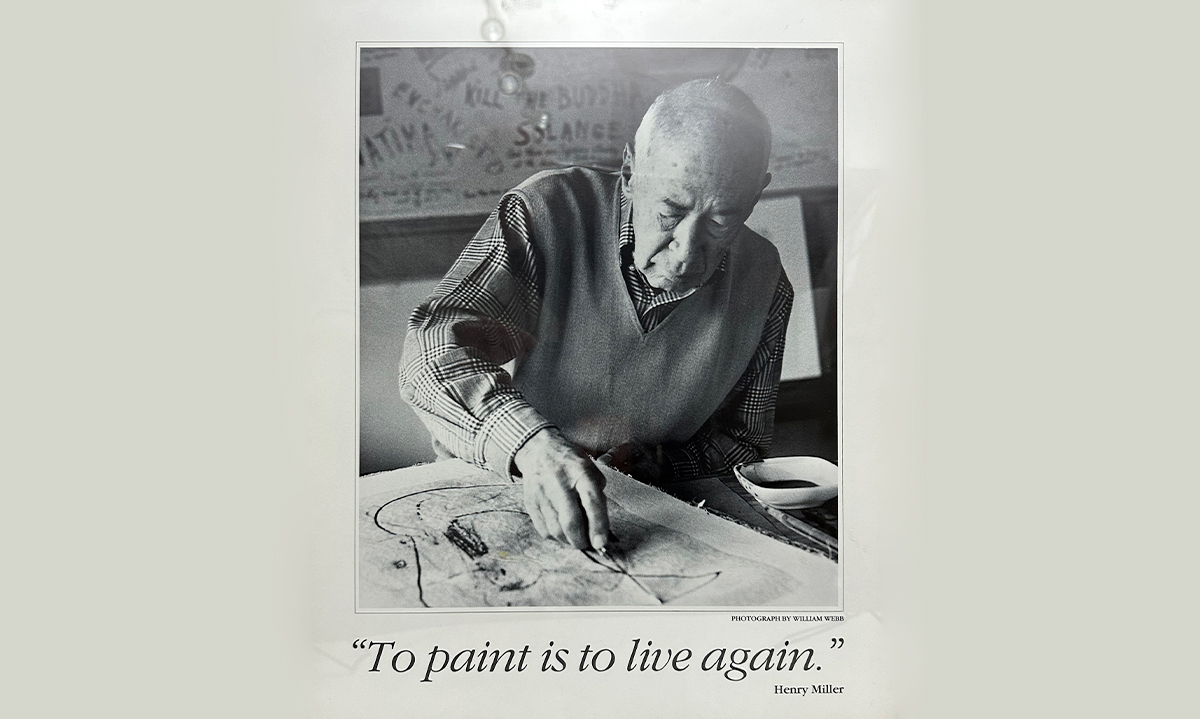
Although best known as an author of such norm-shattering books as Tropic of Cancer and Tropic of
Capricorn, Henry Miller was also an avid watercolorist. Miller had always loved art and began
painting in the late 1920’s, after being inspired by J.M.W. Turner prints exhibited in the window of
a Brooklyn store. Although Miller could not draw well, he made up for it with is use of color and
his sense of composition. In his art, as in his writing, Miller painted from his sub-conscious,
drawing on the same mixture of surrealism and dreams that also punctuated his novels. His
watercolors exhibited, in varying degrees, the influence of European Modernism, Surrealism, Dada,
and Expressionism.
Miller produced numerous watercolors during his life, continuing to paint through his last years (as
evidenced by references to this in his letters to Brenda Venus, also offered in this auction), but
sold very few. In his lean years in New York and Paris, Miller used his paintings for barter,
trading them for paint supplies, coffee, and food. Later on, he gave away the majority of his
paintings to friends and fans around the world.
Miller’s watercolors have been exhibited at the Santa Barbara Museum of Art, California; and Henry
Miller Museum of Art in Ōmachi City, Nagano, Japan, as well as galleries in London, Berlin, Paris,
Los Angeles, and Uppsala, Sweden.
HENRY MILLER'S PERSONAL BOOK COLLECTION
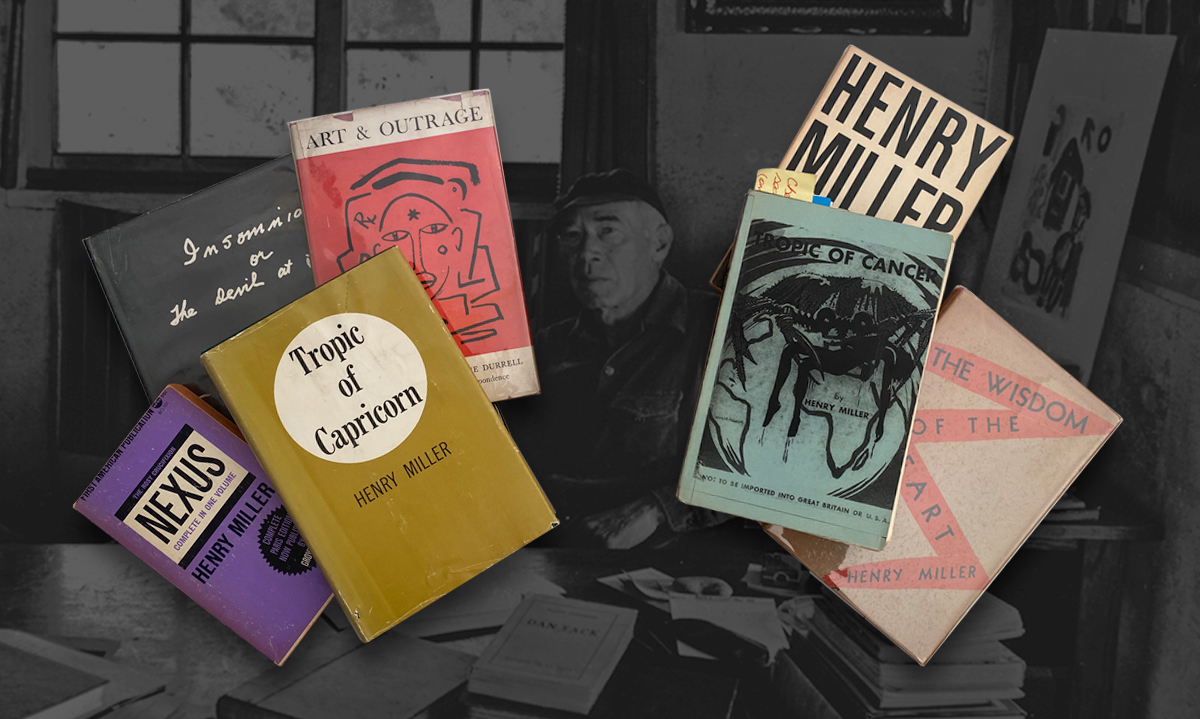
View on Liveauctioneers.com
View on Invaluable.com
50+ Books from Henry Miller’s Personal Library, Gifted to Brenda Venus
Most of the books in this collection were written by Henry Miller, with many inscribed and given to
Brenda. Several of the books were written with or by friends and associates Norman Mailer, Lawrence
Durrell, Alfred Perles, William Gordon, Elmer Gertz and William Webb.
Volumes include Miller’s best known books – “Tropic of Cancer” and “Tropic of Capricorn” – as well
as “Nexus,” “The Wisdom of the Heart,” “The Colossus of Maroussi,” “The Smile at the Foot of the
Ladder.” Particularly touching is a copy of the 1912 Edmondo de Amicis book, “The Heart of a Boy,”
which Miller fondly remembered and wrote about in a in 1980 monograph, just months before he
died.
In addition to the books, the collection also includes nine issues of the rare “Stroker” magazine,
each containing articles and essays by Miller, some of which were accompanied by images of Miller’s
artwork; all dating from 1978 and 1979.
For a complete list of the books and specifics, please click HERE!
HENRY MILLER'S ICONIC BLUE BATHROBE
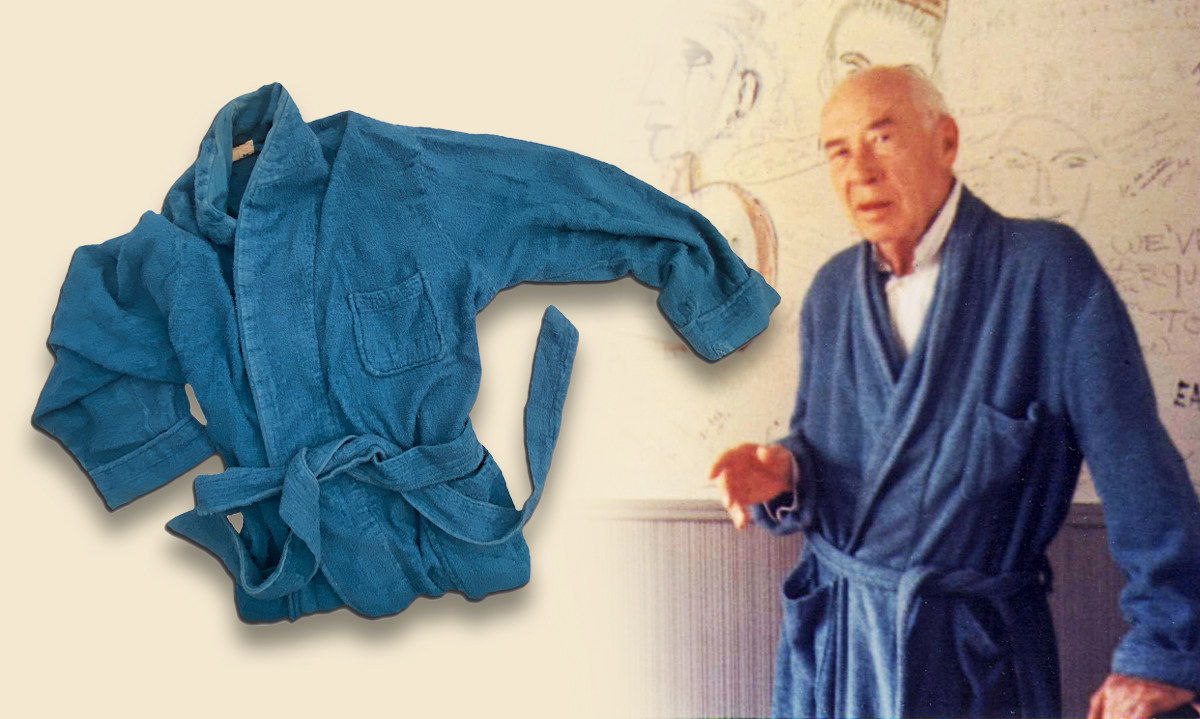
View on Liveauctioneers.com
View on Invaluable.com
Bathrobe is styled with a shawl collar and cuffed sleeves, 1 breast pocket, 2 hip pockets, and
matching tie belt. Size M, 38-40. J C Penney label. Some wear to the neck of the collar and bottom
of both cuffs.
Whether over his pajamas or topping a shirt and trousers, Henry Miller seemed to have worn this blue
bathrobe much in the manner of a traditional smoking jacket. Regardless of the activity – an
interview with a journalist, a visit from an old friend, a quiet dinner, or a late-night painting
session – Miller was rarely without his favorite robe. Miller can be seen wearing this blue bathrobe
in Robert Snyder’s 1969 documentary film, “The Henry Miller Odyssey,” as well as in Joe Kishton’s
1993 film, “Henry Miller is Not Dead.”
In his October 23, 1977, Washington Post article, “A Mad Gaiety, a Verve, a Gusto': Henry Miller
Now,” Kenneth Turan referred to the bathrobe and describes Miller as “somehow managing to look
impishly attractive in a blue terrycloth bathrobe over pinkish pajamas.” Turan again recalls the
bathrobe in his June 11, 1980, Washington Post memorial article, “Memories of Miller.” And Tinka
Thiebaud, an artist and model, who lived with the author as his cook and caretaker, remembered this
blue bathrobe in her book, “What Doncha Know about Henry Miller,” writing: “Henry Miller arrived at
his dinner table each evening wearing one of a thousand masks. I could never anticipate who might
show up in Henry's pajamas and blue terry cloth bathrobe.”
A photograph of Henry Miller, with paint brush in hand and wearing this bathrobe, is reproduced on
page 6 of his book, “The Painting of Henry Miller.” Two copies of this book are included with Lot
#___ of this auction.
HENRY MILLER'S PARISIAN NOTEBOOKS
2 Notebooks of Henry Miller’s Handwritten Entries, both given to Brenda Venus in preparation for her trip to Paris in 1979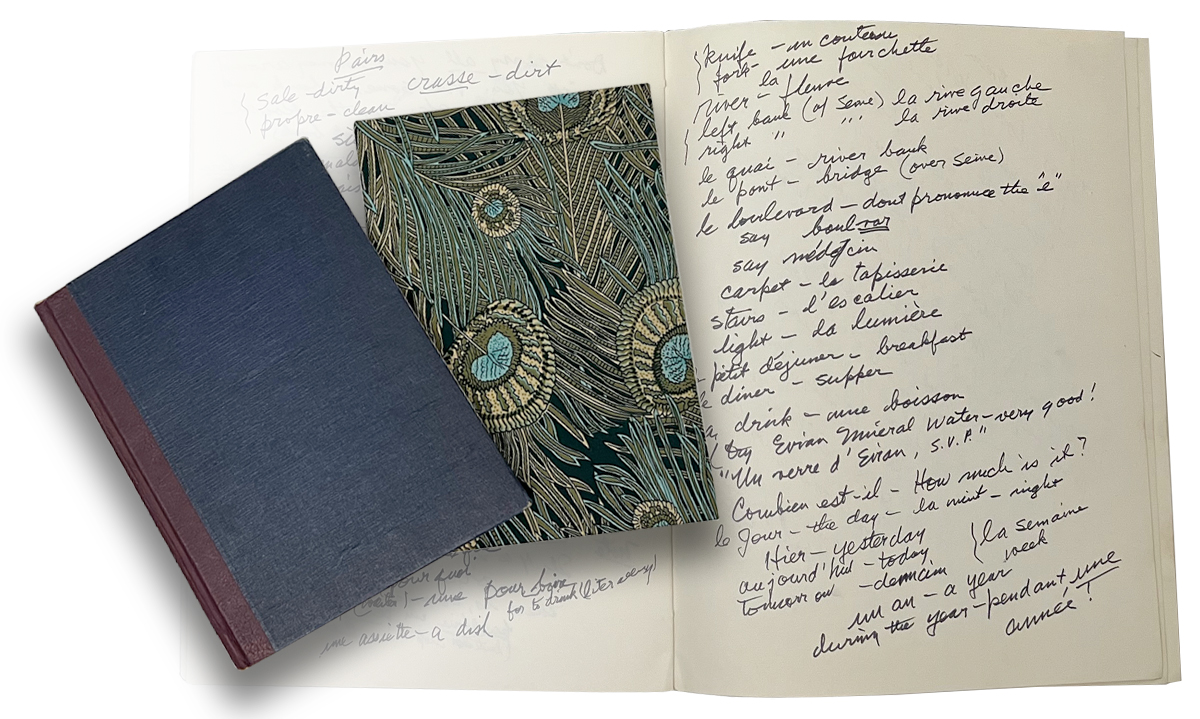
View on Liveauctioneers.com
View on Invaluable.com
A) “Guide Bleu (Blue Guide)” notebook, dark blue cover with maroon spine, measuring 9 x 7 inches.
The origin of “Guide Bleu (Blue Guide),” the name Henry Miller affectionally gave to this notebook, dates back to the author’s years in Paris, 1930 to 1939. Miller used the notebook to record helpful and commonly used French words and phrases, along with their translations, as he acclimated to living in France and became more fluent in the language. In it he made note of museums, dance halls, and bistros, and addresses of friends. Much of the writing in black ink dates to the 30’s. Then in 1979, in preparation for a trip to Paris that Brenda Venus was planning, Miller re-purposed the notebook as a guide for her. Numerous additional entries – some in black ink, many written with red ink – offer advice how to best to enjoy and experience Paris in a meaningful way, rather than simply as a tourist. In addition to his lists of works and translations, Miller recommends how to traverse the city, reminisces about his favorite places in Paris, suggests friends to connect with, and gives assorted other guidance. Several examples follow:
B) Notebook measures 9.25 x 6.25 inches, covered with peacock feather themed printed fabric.
Henry Miller presented this notebook to Brenda Venus, prior to her 1979 trip to Paris. It appears from the entries he made on the front flyleaf and on the first page, it was with the thought that she would use the notebook in the manner of a journal – keeping French words and expressions close at hand, jotting phone numbers and addresses, noting places to visit, sites to see, and people to meet, and recording experiences she could share with Miller upon her return to the States.
Henry Miller’s handwriting on the flyleaf begins with (when translated from French): For my dear Brenda. A notebook for our French phrases that she would like to remember.
Miller then fills the balance of the flyleaf and the first white page of the notebook with more French words, expressions, and questions that Brenda would find helpful in conversation and while interacting with others during her travels.
HENRY MILLER'S LAST LETTER
View on Liveauctioneers.comView on Invaluable.com
Henry Miller passed away on Saturday, June 7, 1980, at the age of 88. In July 1992, Gary Koeppel, owner of Coast Galleries and Publishing which exhibited Henry Miller’s art, sent a letter to Brenda Venus, in which he enclosed an additional letter, writing, “It’s my understanding that this was Henry Miller’s last letter. It may finally be comforting that his last thoughts were about you!”
On his personal letterhead, and dated “Friday or Saturday,” Miller's letter reads:"Brenda, my darling Brenda, I just realize that I am mad crazy, and that’s why you haven’t heard from me. I had got up at midnight thinking it was noon and no one here to breakfast…. I guessed the situation immediately when he said it’s a day later." Clearly confused about what day it is, and in script less fluid than usual, Miller writes: "My God, what am I to do now."
This poignant unfinished letter sadly ends with: "And where am I do go? To the nut house?... Maybe I can go to Big Sur. Maybe to an insane asylum. How come my latest doctor let me go?"
This lot includes the Henry Miller’s handwritten letter with envelope hand-addressed to Brenda Venus (with uncancelled 15 cent stamp) , as well as Gary Koeppel’s 1992 handwritten letter and envelope.

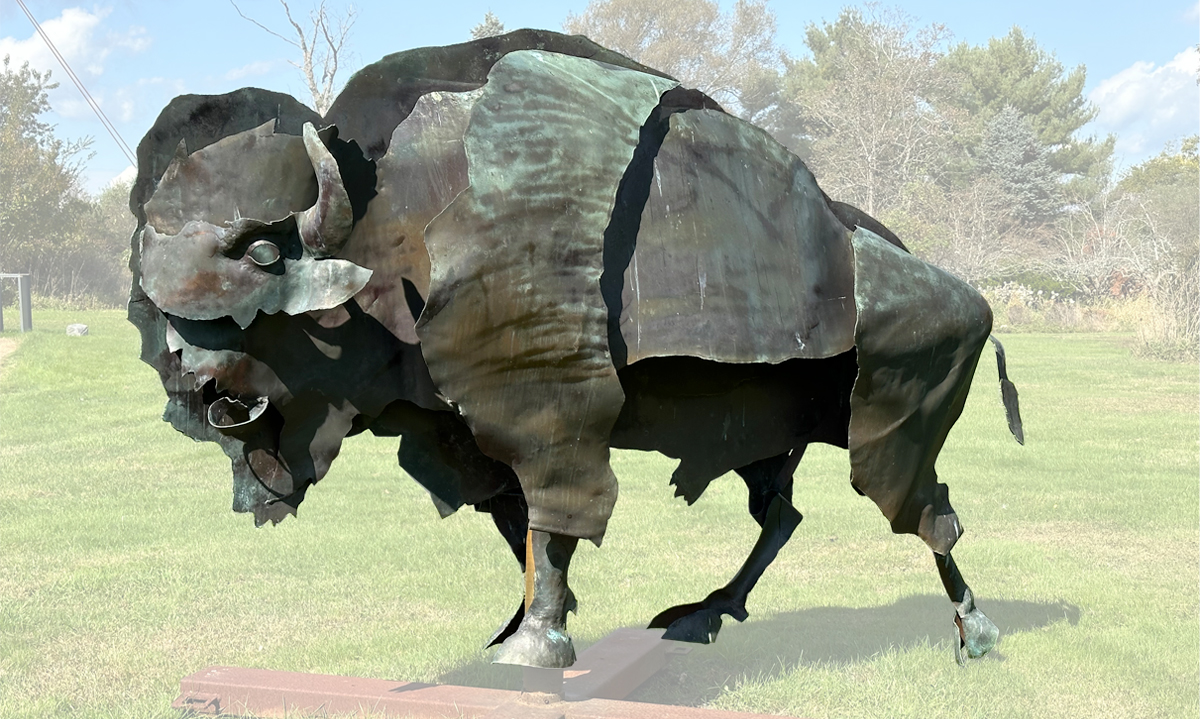
THE BUFFALO
View on Liveauctioneers.comView on Invaluable.com
American Buffalo, Robert Berks, 1992.
Renowned sculptor Robert Berks crafted this unique tribute to the American Buffalo of heavy,
11-gauge copper sheet which has developed a handsome, weathered patina. 80” high (plus 10” iron
base) x 122” wide.
The Buffalo
In a project never realized, Berks envisioned a herd of as many as 1,000 American buffalo, made of
copper, roaming the Oregon Train in Wyoming. As reported in Newsweek at the time, Berks’ copper herd
was to serve as a "monument for the ages, lasting a thousand years." The project was in recognition
of the great herds lost forever. This singular sculpture resulted from that effort.
Robert Berks, 1922 - 2011
The headline of a New York Times article about sculptor Robert Berks called him the “Capital’s
Michelangelo.” Although Berks is probably best known for his heroic eight-foot-high head of
President John F. Kennedy that presides over Washington D.C.’s Kennedy Center for the Performing
Arts, there are at least eight other large public works by Berks in that city, and numerous others
scattered across the United States. A number of sculptured busts by Robert Berks are part of the
permanent collection of the National Portrait Gallery; several others are on display in the White
House.
Berks’ tableau in bronze pays tribute to Mary McLeod Bethune, and is the first monument to honor a
Black woman to be erected on public land in the nation’s capital. Situated on the grounds of the
National Academy of Sciences, Robert Berks’ twelve-foot seated figure of Albert Einstein welcomes
all who wish to learn. And Chicago’s Botanic Garden is home to Berks’ monumental work depicting Carl
Linneaus.
Berks gained international recognition in 1952, when his sculptural bust of Dr. Chaim Weizmann,
Israel’s first president, was chosen as the definitive portrait of the late statesman-scientist. In
the course of his career, Robert Berks created more than 300 hundred sculptural portraits of
individuals in public and private life – American presidents and statesman (Abraham Lincoln,
Franklin Roosevelt, John F. Kennedy, Lyndon Johnson, Richard Nixon, Robert Kennedy), international
leaders (Golda Meir, Abba Eban, Pope Paul VI), industrialists (John Paul Getty), Civil Rights
leaders (Martin Luther King, Mary McLeod Bethune), scientists (Albert Einstein, Mathide Krim),
jurists (Louis Brandeis, Ramsey Clark), and personalities from the arts (Pablo Casals, Leonard
Bernstein, Bob Hope, Alastair Cooke, Ernest Hemingway and Johnny Carson). Robert Berks was the first
sculptor to have his work appear on the cover of Time Magazine.
Coincidental with preparations for the auction of this important sculptural work is the release of
Ken Burns’ 4-hour documentary about the American Buffalo.

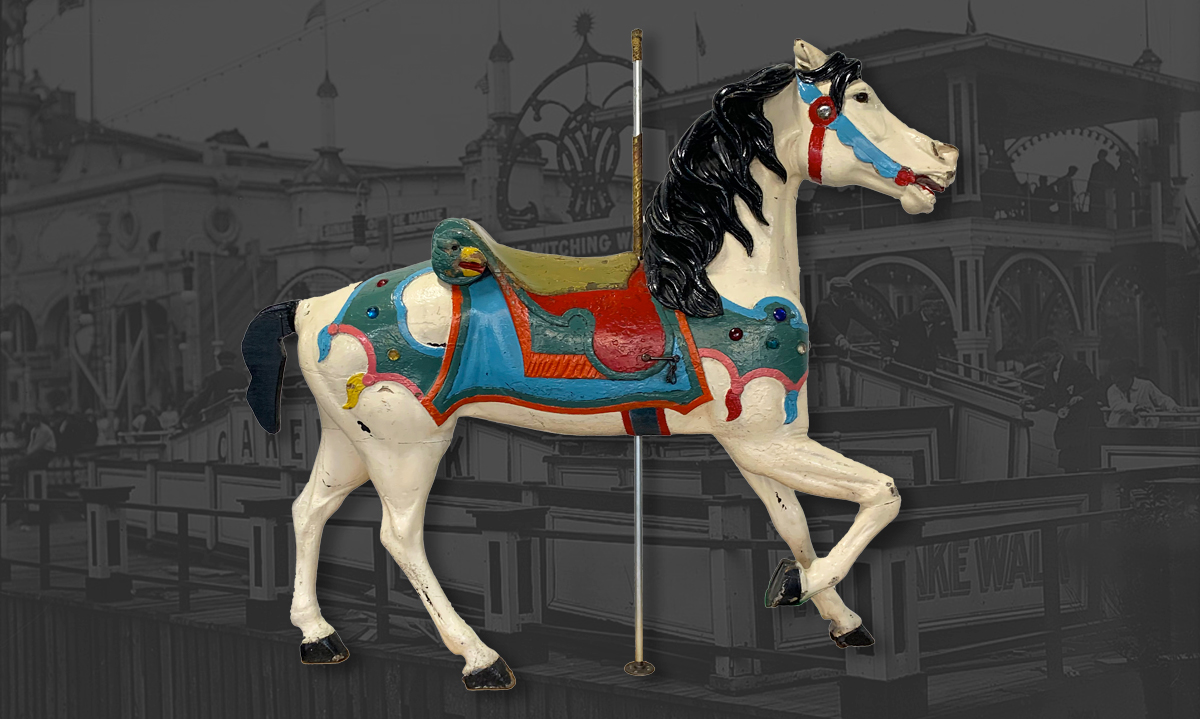
THE CONEY ISLAND CAROUSEL HORSE
View on Liveauctioneers.comView on Invaluable.com
1915 Carousel Outer Row Horse, Charles Carmel
A century ago, going out on a date often included a visit to the carousel. Although now extremely
rare, carousels (aka: merry-go-rounds) were once so popular that five thousand machines populated
the American countryside. Most of these contained from thirty to fifty carved wooden horses and
other “menagerie” animals. A community was considered fortunate to be in possession of a carousel
carved by one of 9 dedicated carving studios. One of the most legendary of these was that of
Brooklyn’s own Charles Carmel.
The saga of this handsome vintage Charles Carmel carousel outer row standing* horse, 60” h x 64” w,
is nothing short of extraordinary. Hand-carved at Carmel’s Ocean Parkway (Brooklyn, NY) workshop, it
rode on a grand Coney Island carousel for twenty five years. However, with the depression, interest
in amusement parks wained and this complete Carmel carousel was sold to a buyer in, of all places,
Bogota, Colombia. There, for the next half century, the horses spun to the delight of the children
from that South American city. (*Outer row “standers” were the best of the best.)
In the 1980’s, an American gentleman, in Bogota on business, spotted workers dismantling the old
carousel. On his return to the States, he contacted Guernsey’s which for years had built a
reputation for offering the finest vintage carved figures. With nothing else to gone go on, the head
of the auction house traveled to Colombia and, following a week-long search, found the more than
fifty horses that had ridden on the now fabled machine.
Convincing the carousel’s owner that the discovery of these horses would cause excitement were they
returned to the States, the carvings were then transported through terrorist-held land until they
reached the coast and a ship ready to bring them to New York, the city from which they originally
came.
Three large containers were delivered directly to the grounds of NYC’s Lincoln Center for the
Performing Arts where, under the tent of the Big Apple Circus, an auction of these animals was to
take place. Also in the sale: the complete Coney Island Wax Museum. However, as soon as the
containers were opened and as the horses were about to be carried into the tent, uniformed DEA
agents swooped in believing the cavities of these beautiful carved animals might indeed contain
illicit material. Once convinced that this was not the case, the auction proceeded with the Carmel
horses fetching record amounts.
After being loved by the family of the buyer from that Guernsey’s 1980’s auction, this wonderful
horse is being offered again.

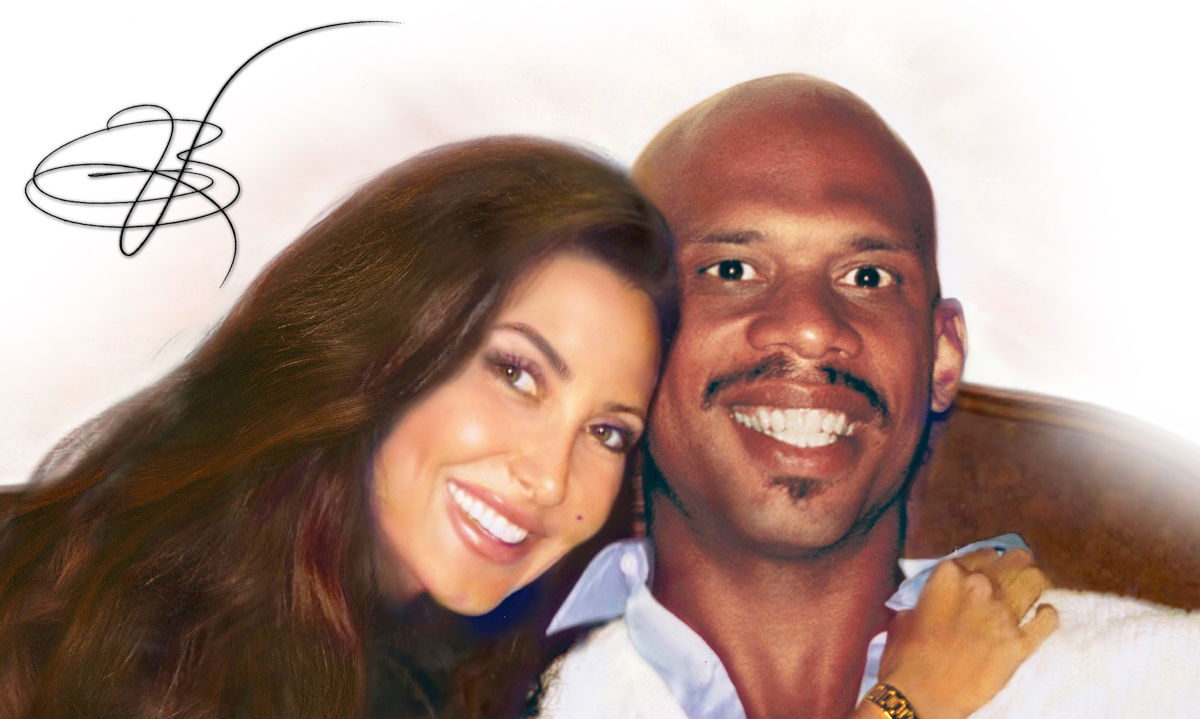
KAREEM ABDUL-JABBAR & BRENDA VENUS
View on Liveauctioneers.comView on Invaluable.com
A record six-time Most Valuable Player, the NBA’s Kareem Abdul-Jabbar has been called “the greatest
basketball player of all time” by such accomplished figures as Pat Riley, Isiah Thomas and Julius
Irving. Starting in 1969 and over a twenty year career, Abdul-Jabbar’s feats on the court were
remarkable and many.
In 1983, the legendary athlete met Brenda Venus, beauty queen and film actress. Ms. Venus had been
romantically linked to the famed author and one of the twentieth century's most important literary
figures, Henry Miller, until his death in 1980. Indeed, this auction - in addition to the following
Kareem Abdul-Jabbar / Brenda Venus lots - also features an important collection of letters written
to Brenda by Mr. Miller along with other Henry Miller-related objects.
When Kareem met Brenda, sparks flew. Documented in her book Kareem, A Precious Love, their
torrid romance - starting at the height of Abdul-Jabbar's career - lasted years. The following lots
- consigned directly by Ms. Venus - reflect on that loving relationship.
Kareem Letters - Lot 9
9 (nine) letters and notes handwritten by Kareem Abdul-Jabbar from 1983 - 1985 during the height of
his NBA career. The letters were written to Ms. Brenda Venus with whom the basketball great was
romantically involved. All are signed “Kareem." Some are written on ruled paper, others on
stationary with an Art Deco border while two on are on hotel stationary - Camelback Sahara and
Bellevue Stratford.
Among the many quotable excerpts are "I’ve always had a poor self image. Being black and awkward
when all around me were white and seemingly capable, I didn’t learn of my true strength until
late in the game and I always retained self doubts.” and "This ugly duckling truly knows
now that he has grown into a black swan.”
Kareem Letters - Lot 10
9 (nine) letters and notes handwritten by Kareem Abdul-Jabbar mostly written from 1983 through the
late 1980’s during his remarkable basketball career. 1 letter (with envelope) from 1993. Some
written on stationary with Art Deco border, one on Kareem Abdul-Jabbar letterhead and others from
hotels in Atlanta and Bangladesh. The letters were written to Ms. Brenda Venus with whom the
basketball great was romantically involved. All are signed “Kareem."
Among the quotable excerpts is "I have never felt this type of loneliness in my life before. I
have been alone in Milwaukee and at boarding school. I’ve been the only black person in all
white environments…”
Kareem Letters - Lot 11
9 (nine) letters and notes handwritten by Kareem Abdul-Jabbar from 1987 - 2015. Includes a lengthy
2-page 1987 letter on Marriott Hotel stationary which was written while Kareem was still a powerful
force in the NBA. Among the others, one is written on “Kareem Productions” letterhead. Others on
stationary with Art Deco border, note paper, etc. The letters were written to Ms. Brenda Venus with
whom the basketball great was romantically involved. All are signed “Kareem.”
A quotable excerpt from the Nov. 10, 1987 letter: “At this point we have a unique perspective on
life because we’re at the mid point where we can look back and project ahead. As we get older
the past begins to fade into that mist and the future keeps shortening up… The Muslims believe
the gift of time is the most special that we receive because it allows us to do the things that
assure our salvation. The hours and days of our lives are our most precious commodity. We get to
spend them once and thats it. When they’re all gone we return to Allah and hand in our report
card."

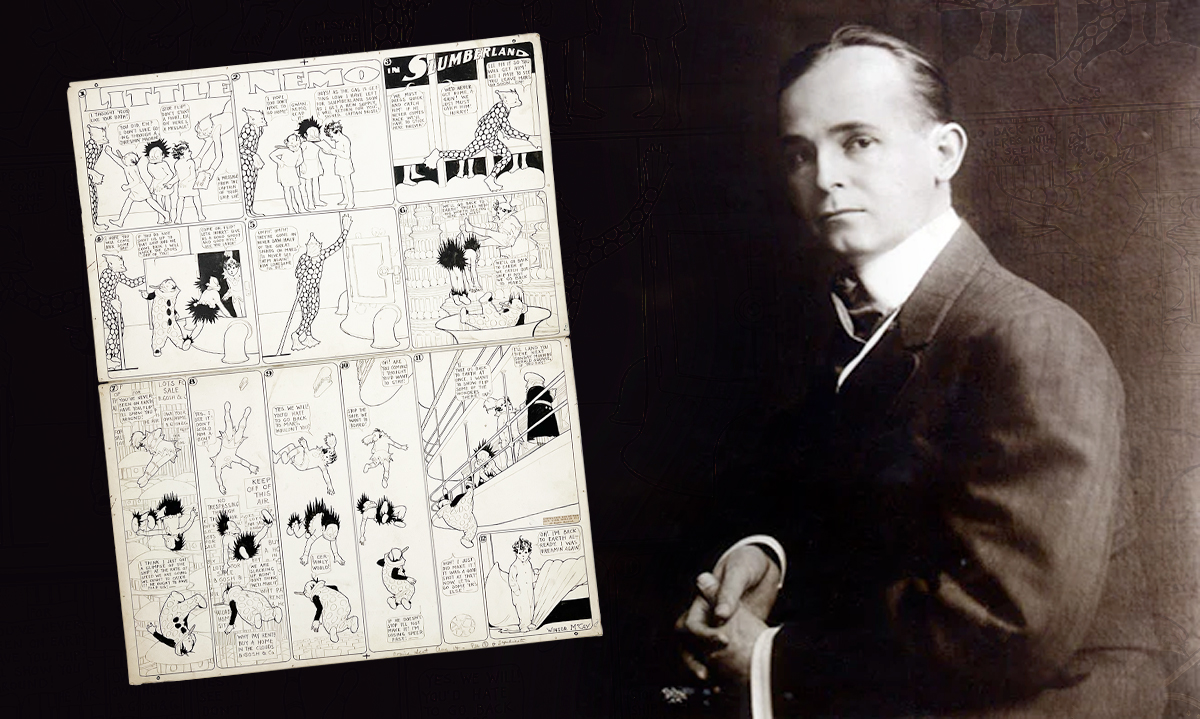
WINSOR MCCAY'S LITTLE NEMO, ADVENTURES IN SLUMBERLAND
View on Liveauctioneers.comView on Invaluable.com
Little Nemo in Slumberland, Winsor McCay Sunday comic strip original art, August 14, 1910
28.5” x 22.5," signed bottom right. Very good condition. In pencil, bottom edge: “Comic Sect Aug 14
- Pge 1 & Syndicate.” Newsprint cut attached lower right: (Copyright, 1910, by The New York
Herald Co.)
Universally recognized as one of the twentieth century's greatest and most influential cartoonists,
few came close to Winsor McCay’s stunning illustrations and imaginative genius. And though his
landmark comic strips included the memorable Dreams of the Rarebit Fiend and Little Sammy Sneeze,
his true masterpiece was Little Nemo in Slumberland. Taking the reader through a maze of dreamlike
fantasies, Little Nemo today is considered amongst the most sophisticated, and certainly most
beautiful of all comic strips.
The Sunday full-page “strip” we are honored to be offering has remained in the McCay family to his
day. It has never been offered for sale before. Appearing on August 14, 1910, it was from the early
years of Little Nemo and includes the title character (Nemo) and his friends - Impi and Flip.
In this strip, the threesome depart from Mars and head back to Earth while their Martian host (with
scaly skin and webbed feet) is sad to see them go. Nemo, Impi and Flip are shot through a
cannon-like device hoping to reach their ship and voyage home. As they hurtle though space, the
three fly by signs including “KEEP OFF OF THIS AIR” and “WHY PAY RENT! BUY A HOME IN THE CLOUDS - B.
GOSH & CO” Arriving at their ship just in time, Captain Drisel assures them that they’ll land
“next Sunday morning, Herald Square.” (Herald Square, as many know, is on 34th Street, NYC.)
Provenance:
Family of Winsor McCay


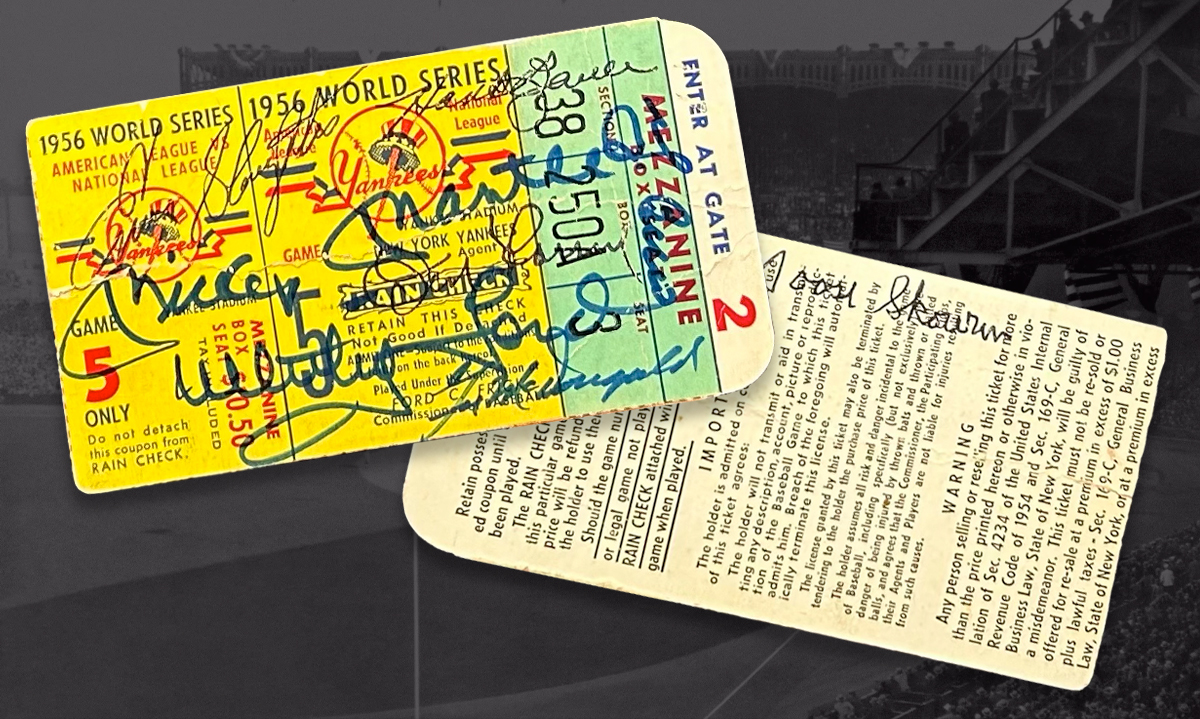
THE "PERFECT GAME" STUB
View on Liveauctioneers.comView on Invaluable.com
1956 Baseball World Series Ticket Stub - Don Larsen's Perfect Game
1956 Baseball World Series Ticket Stub, Game 5, Yankee Stadium, Section 38, Box 250, Seat 3. NY
Yankees vs. Brooklyn Dodgers. Signed on front: Don Larsen, Mickey Mantle, Yogi Berra, Whitey Ford,
Enos Slaughter, Gil McDougal, Hank Bauer; signed on verso: Moose Skowron. Authenticated: Beckett
Authentication Services.
With World War II behind us, and the Cold War yet to flare up, the 1950’s were heady times. On the
ball field, the Yankees were king. From 1950 through 1958, they won the World Series an
unprecedented six times, grabbing the American League pennant two of the other three years. With a
powerful line-up of future Hall of Famers, the Bronx Bombers were a hard team to beat.
In all of sports, there are certainly legendary rivalries. Today, Ohio State and Michigan is one of
them; and for those old enough, who can forget Ali-Frazier? But in the fifties, the setting couldn’t
be more dramatic than when New York City’s two most legendary teams - the Yankees and Brooklyn
Dodgers - clashed.
In 1956, the two teams won their respective pennants, setting up a much anticipated “subway series.”
By the time Game 5 was reached, the Yanks and Bums were knotted at two games each. Fittingly, it was
being played on arguably the most famous field in all of sports - Yankee Stadium. On the mound was
Brooklyn’s great Sal Maglie; for the team in pinstripes, it was to be largely unheralded pitcher,
Don Larsen.
The rest is what legends are made of.
What resulted on October 8, 1956 at 1pm in the Bronx was one of the great moments in baseball -
indeed, in all of sports - history. Don Larsen pitched his fabled “perfect game.” That this was the
first perfect post-season game ever is just one of the stunning statistics resulting from Larsen’s
performance. That the pitcher allowed only one batter to reach a “3-ball count” is another. And that
the competition included such stand-outs as Jackie Robinson, Duke Snyder, Pee Wee Reese and Gil
Hodges adds a mind-boggling dimension.
Today, what fan of the game isn’t familiar with Yogi’s leap into Larsen’s arms after the final
strike? The moments has, and will forever, live on.
The Stub:
Perched directly behind home plate, the original owner of this ticket - Seat 3, Box 250, Section 38
- was certainly eyewitness to one of the great events in sports history. As a game never to be
forgotten, the Stub was signed by "perfect game" pitcher Don Larsen, as well as Mickey Mantle, Yogi
Berra, Whitey Ford, Enos Slaughter, Gil McDougal, Hank Bauer and Bill “Moose” Skowron. Mantle,
Berra, Ford and Slaughter, of course, are all Hall of Famers and, with the exception of pitcher
Whitey Ford, played in the game. In addition, Larsen (obviously), McDougal (1951 Rookie of the Year
and 5-time All Star), Bauer (3-time All Star) played in the game while beloved slugger Moose Skowron
was not in the line-up that day.
Owner's Comments:
"I owned a sports store at the Jersey Shore and one August afternoon in 1987 an older gentleman
walked in and asked me if I would be interested in purchasing a baseball ticket. I took a look at it
and immediately realized what I was looking at at. I almost couldn’t believe it. I purchased it and
kept it in a safety box until 1991. Having been a Yankee season holder since 1972, I decided at that
time to set out and get as many signatures as possible. I attended Old Timers day games year after
year getting as many signatures as I could. It wasn’t until 2006 that I finally got Don Larsen to
sign. Some time later I emailed the Hall (of Fame) and told them about my ticket. Clearly, they were
excited about the possibility that it might be donated.”


UNCLE SAM "I WANT YOU!" RECRUITMENT SIGN
View on Liveauctioneers.comView on Invaluable.com
“I Want You” Double-sided Metal Recruiting Sign
I Want You for the U.S. Army, James Montgomery Flagg, double-sided metal U.S. Army recruiting sign,
38” x 25.” Excellent condition with a 2” scratch on one edge and minor scrapes elsewhere.
James Montgomery Flagg’s iconic “I Want You” poster was, without question, one of the most memorable
images to emerge from World War I, and indeed is legendary within the world of illustration. While
tens of thousands of Flagg’s paper posters were distributed across America, far fewer metal,
double-sided signs were fabricated. So powerful was Flagg’s Uncle Sam that the same art was used for
recruiting troops as America entered World War II. Designed to be placed in stands often in front of
U.S. Army recruitment centers, few are known to have survived.
This example was found packed in the attic of a rural home and has survived with only a few small
scratches.

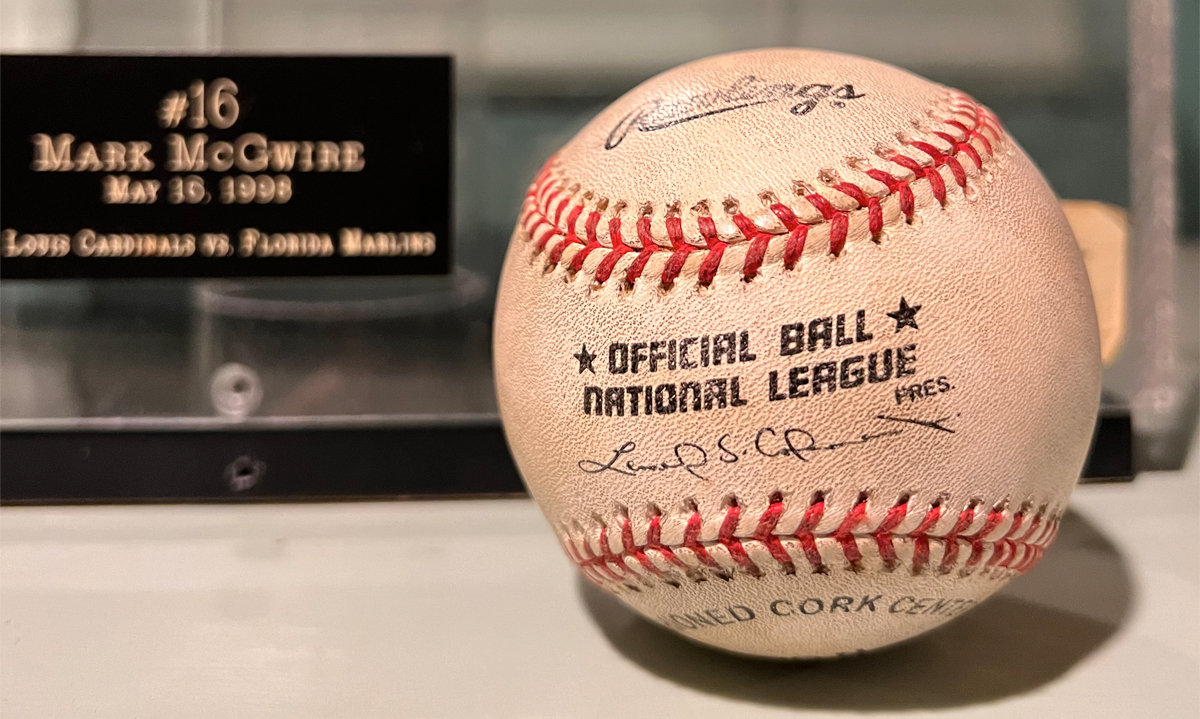
MARK MCGWIRE'S 16TH HOMERUN BASEBALL
View on Liveauctioneers.comView on Invaluable.com
Mark McGwire 16th Home Run Baseball
On May 16th, 1998, the Cardinals played the Marlins at Busch Stadium in St. Louis, Missouri. The
Cardinals were down 3 to 1 in the fourth inning when Livian Hernandez, the 1997 World Series MVP,
threw a home run pitch to McGwire, keying a three run rally, resulting in a 5-4 victory for the
Cardinals. This home run soared 545 feet into center field, denting the Post Dispatch sign hanging
from the upper deck. Subsequently, a Band-Aid was placed over the spot where the baseball dented the
sign. This home run baseball, the 403rd of McGwire's career, is the longest home run of Mark
McGwire's career and the longest home run ever to be hit in Busch Stadium.

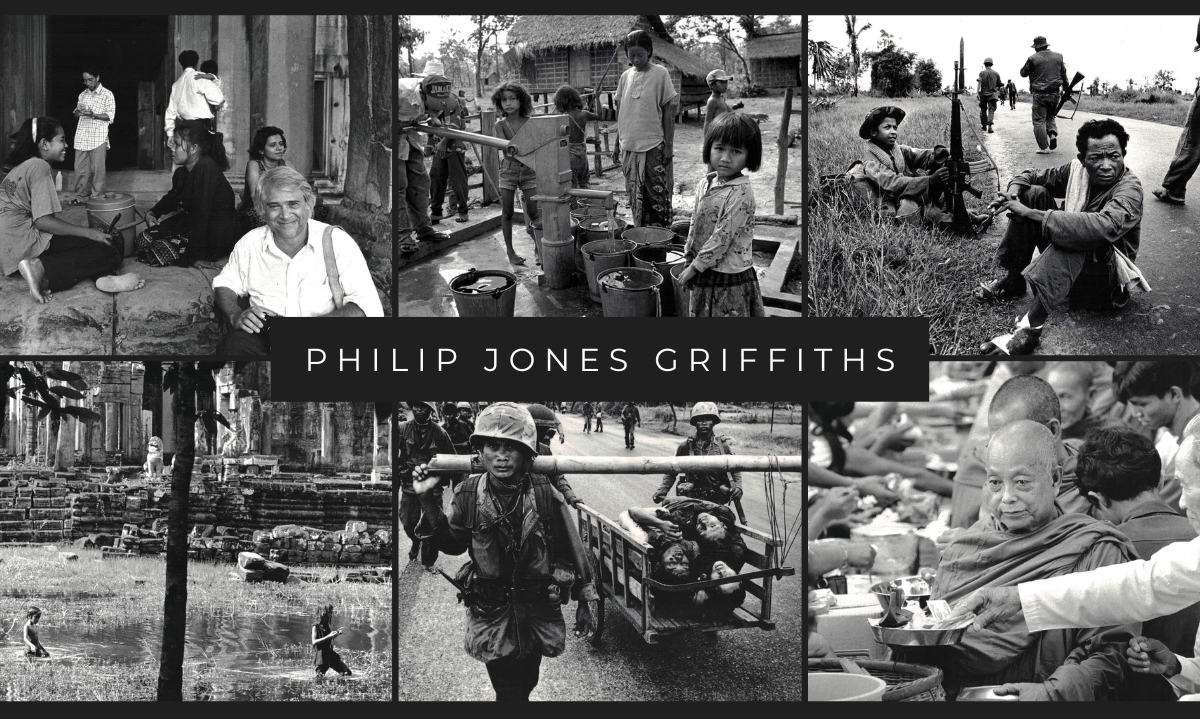
PHILLIP JONES GRIFFITHS PHOTOGRAPHY COLLECTION
View on Liveauctioneers.comView on Invaluable.com
Philip Jones Griffiths Photography Collection
Eighty one (81) - 8” x 10” black & white photographs taken by internationally respected Welsh
photographer Philip Jones Griffiths while covering the Viet Nam War. Very fine condition. While nine
(9) of the prints have blank, unmarked versos, most of the prints bear one of two different stamps
with the photographer’s name along with "Magnum Photos,” the photographers’ cooperative Mr.
Griffiths presided over from 1980 - 1985. The majority have a satin/matte finish and may be silver
gelatin prints. A few of the prints have a glossy finish. There are several duplicates in the
Collection, and one print is laminated.
Depicting the horrors of war, Mr. Griffiths’ work focuses both on the combatants and on the
innocent. In addition to battle scene casualties and the war’s impact on civilians - including many
children - there are also shots that appear to have been taken in adjacent Laos in settings
reminiscent of the centuries-old temples seen in the landmark film, Apocalypse Now.
The Philip Jones Griffiths Archive is contained within The National Library of Wales. Famed French
photographer Henri Cartier-Bresson said of Griffiths' "Not since Goya has anyone portrayed war like
Philip Jones Griffiths.”
ONLINE BIDDING
Those who are interested in participating can view the catalogue online, and leave advance absentee bids, as well as bid live as the sale is taking place at Liveauctioneers.com and Invaluable.com.
LINKS
Interested bidders should also review the Terms & Conditions, as well as the Bidder Agreement Form, and the Absentee Bid Form.
PRESS
Guernseys: Press ReleaseReuters: Bob Dylan, Elvis Presley items hit auction block
BBC: Listen to audio clip from Bob Dylan’s first album before it goes to auction
New York Times: Bob Dylan Sings, and Talks, on These Tapes From 62 Years Ago
The Michael Smerconish Program (SiriusXM): Arlan Ettinger on the Auctioning of The Beatles' White Album
Van Halen News Desk: Eddie Van Halen's Guitar Gifted To Jason Becker For Auction
The Music Universe: Guernsey’s to auction rare Bob Dylan, Elvis, Eddie Van Halen, The Beatles treasures
Modern Luxury, Aspen: Buy Bob Dylan's Master Tapes, JFK's Moon-Landing Note And More At Auction
Guitar.com: The Wolfgang guitar Eddie Van Halen gifted to Jason Becker is going up for auction
Gotham Magazine: Buy Bob Dylan's Master Tapes, JFK's Moon-Landing Note And More At Auction
The Atlantan: Buy Bob Dylan's Master Tapes, JFK's Moon-Landing Note And More At Auction
Modern Luxury, Palm Beach: Buy Bob Dylan's Master Tapes, JFK's Moon-Landing Note And More At Auction
Yahoo News Singapore: Bob Dylan, Elvis Presley items hit auction block
Hamptons Magazine: Buy Bob Dylan's Master Tapes, JFK's Moon-Landing Note And More At Auction
Modern Luxury, North Shore: Buy Bob Dylan's Master Tapes, JFK's Moon-Landing Note And More At Auction
Yahoo News: Bob Dylan, Elvis Presley items hit auction block
Ocean Drive Magazine: Buy Bob Dylan's Master Tapes, JFK's Moon-Landing Note And More At Auction
Knowledia: Listen to audio clip from Bob Dylan’s first album before it goes to auction
News9 Live: Bob Dylan, Elvis Presley items hit auction block
Modern Luxury, Riviera: Buy Bob Dylan's Master Tapes, JFK's Moon-Landing Note And More At Auction
Spot On Florida: Buy Bob Dylan's Master Tapes, JFK's Moon-Landing Note And More At Auction
VOV.VN: "Album trắng" của nhóm The Beatles sắp được đưa ra đấu giá
MSN: Bob Dylan, Elvis Presley items hit auction block
Vietgiaitri.com: ‘Album trắng’ của nhóm The Beatles sắp được đưa ra đấu giá
Los Angeles Confidential: Buy Bob Dylan's Master Tapes, JFK's Moon-Landing Note And More At Auction
Boston Common: Buy Bob Dylan's Master Tapes, JFK's Moon-Landing Note And More At Auction
Modern Luxury, Dallas: Buy Bob Dylan's Master Tapes, JFK's Moon-Landing Note And More At Auction
نافذة على العالم: Listen to audio clip from Bob Dylan’s first album before it goes to auction
Modern Luxury, Hamptons: Buy Bob Dylan's Master Tapes, JFK's Moon-Landing Note And More At Auction
Modern Luxury, Hawaii: Buy Bob Dylan's Master Tapes, JFK's Moon-Landing Note And More At Auction
Modern Luxury, Houston: Buy Bob Dylan's Master Tapes, JFK's Moon-Landing Note And More At Auction
Yahoo News, France: Bob Dylan, Elvis Presley items hit auction block
MetroPulse.com: Cool stuff for sale…
Modern Luxury, Silicon Valley: Buy Bob Dylan's Master Tapes, JFK's Moon-Landing Note And More At Auction
Modern Luxury, Scottsdale: Buy Bob Dylan's Master Tapes, JFK's Moon-Landing Note And More At Auction
Peak: Buy Bob Dylan's Master Tapes, JFK's Moon-Landing Note And More At Auction
OceanDrive: Buy Bob Dylan's Master Tapes, JFK's Moon-Landing Note And More At Auction
Chicago Social: Buy Bob Dylan's Master Tapes, JFK's Moon-Landing Note And More At Auction
Vegas Magazine: Buy Bob Dylan's Master Tapes, JFK's Moon-Landing Note And More At Auction
ML Manhattan: Buy Bob Dylan's Master Tapes, JFK's Moon-Landing Note And More At Auction
Philidelphia Style: Buy Bob Dylan's Master Tapes, JFK's Moon-Landing Note And More At Auction
Modern Luxury, San Diego: Buy Bob Dylan's Master Tapes, JFK's Moon-Landing Note And More At Auction
San Francisco Magazine: Buy Bob Dylan's Master Tapes, JFK's Moon-Landing Note And More At Auction
Uncut: Bob Dylan masters at auction
Blabbermouth.Net: Guitar EDDIE VAN HALEN Gifted To JASON BECKER Is Going Up For Auction
Guitar World: “Jason’s most treasured instrument”: The guitar Eddie Van Halen gifted Jason Becker during their emotional first meeting is heading to auction
Daily News: Can be found on page 20.
Y! Entertainment: “Jason’s most treasured instrument”: The guitar Eddie Van Halen gifted Jason Becker during their emotional first meeting is heading to auction
Truth In Shredding: Jason Becker, Edward Van Halen: upcoming auction of Jason's Edward Van Halen's Wolfgang 91000069
Joe Bonnamassa: Watch Eddie Van Halen, Steve Lukather & Billy Sheehan cover Jimi Hendrix, Led Zeppelin and The Beatles at a 1996 ALS Benefit Concert for Jason Becker
DarkSide: JASON BECKER продаст гитару Эдди зимой
TrueMetal: Jason Becker: in vendita la chitarra regalatagli da Eddie Van Halen
ML Angeleno: Buy Bob Dylan's Master Tapes, JFK's Moon-Landing Note And More At Auction
Van Halen News Desk: Talking Dddie Van Halen Peavey Wolfgang Guitars With Jim Decola Of Gibson - VIDEO
Detroit Free Press: Bob Dylan's first album could change a blind Detroit artist's life
Guitar World: “The last person to really play it like that was Ed”
